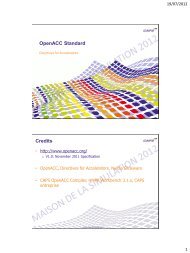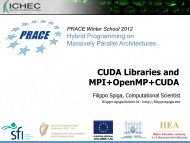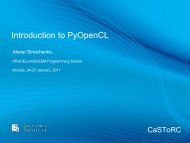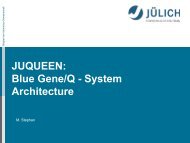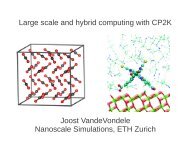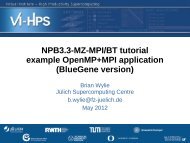Hybrid MPI & OpenMP Parallel Programming - HLRS
Hybrid MPI & OpenMP Parallel Programming - HLRS
Hybrid MPI & OpenMP Parallel Programming - HLRS
- No tags were found...
Create successful ePaper yourself
Turn your PDF publications into a flip-book with our unique Google optimized e-Paper software.
Outlineslide number• Introduction / Motivation 2• <strong>Programming</strong> models on clusters of SMP nodes 6• Case Studies / pure <strong>MPI</strong> vs hybrid <strong>MPI</strong>+<strong>OpenMP</strong> 13• Practical “How-To” on hybrid programming 4114:30 – 16:10• Mismatch Problems 81• Opportunities: Application categories that can 110benefit from hybrid parallelization• Thread-safety quality of <strong>MPI</strong> libraries 120• Tools for debugging and profiling <strong>MPI</strong>+<strong>OpenMP</strong> 12616:30 – 17:20• Other options on clusters of SMP nodes 133• Summary 147• Appendix 155• Content (detailed) 172<strong>Hybrid</strong> <strong>Parallel</strong> <strong>Programming</strong>Slide 2 / 154Rabenseifner, Hager, Jost
Motivation• Efficient programming of clusters of SMP nodesSMP nodes:• Dual/multi core CPUs• Multi CPU shared memory• Multi CPU ccNUMA• Any mixture with shared memory programming modelSMP nodesNode Interconnectcoressharedmemory• Hardware range• mini-cluster with dual-core CPUs• …• large constellations with large SMP nodes… with several sockets (CPUs) per SMP node… with several cores per socket Hierarchical system layout• <strong>Hybrid</strong> <strong>MPI</strong>/<strong>OpenMP</strong> programming seems natural• <strong>MPI</strong> between the nodes• <strong>OpenMP</strong> inside of each SMP nodeCoreCPU(socket)SMP boardccNUMA nodeCluster of ccNUMA/SMP nodes<strong>Hybrid</strong> <strong>Parallel</strong> <strong>Programming</strong>Slide 3 / 154Rabenseifner, Hager, Jost
MotivationSMP nodeSocket 1<strong>MPI</strong><strong>MPI</strong><strong>MPI</strong>Quad-core process4 x CPU multithreadedprocess<strong>MPI</strong> <strong>MPI</strong><strong>MPI</strong>8 x multithreaded<strong>MPI</strong><strong>MPI</strong><strong>MPI</strong>Quad-core process4 x CPU multithreaded<strong>MPI</strong> <strong>MPI</strong>Socket 2SMP nodeSocket 1<strong>MPI</strong><strong>MPI</strong><strong>MPI</strong>Quad-core process4 x CPU multithreadedprocess<strong>MPI</strong> <strong>MPI</strong><strong>MPI</strong>8 x multithreaded<strong>MPI</strong><strong>MPI</strong><strong>MPI</strong>Quad-core process4 x CPU multithreaded<strong>MPI</strong> <strong>MPI</strong>Socket 2• Which programming modelis fastest?• <strong>MPI</strong> everywhere?• Fully hybrid<strong>MPI</strong> & <strong>OpenMP</strong>?• Something between?(Mixed model)Node Interconnect• Often hybrid programmingslower than pure <strong>MPI</strong>– Examples, Reasons, …?<strong>Hybrid</strong> <strong>Parallel</strong> <strong>Programming</strong>Slide 4 / 154Rabenseifner, Hager, Jost
Goals of this tutorial• Sensitize to problems on clusters of SMP nodessee sections Case studies Mismatch problems• Technical aspects of hybrid programmingsee sections <strong>Programming</strong> models on clusters Examples on hybrid programming• Opportunities with hybrid programmingsee section• Issues and their Solutions Opportunities: Application categoriesthat can benefit from hybrid paralleliz.with sections Thread-safety quality of <strong>MPI</strong> libraries Tools for debugging and profilingfor <strong>MPI</strong>+<strong>OpenMP</strong>•Lessfrustration&•Moresuccesswith yourparallelprogram onclusters ofSMP nodes<strong>Hybrid</strong> <strong>Parallel</strong> <strong>Programming</strong>Slide 5 / 154Rabenseifner, Hager, Jost
Outline• Introduction / Motivation• <strong>Programming</strong> models on clusters of SMP nodes• Case Studies / pure <strong>MPI</strong> vs hybrid <strong>MPI</strong>+<strong>OpenMP</strong>• Practical “How-To” on hybrid programming• Mismatch Problems• Opportunities:Application categories that can benefit from hybrid parallelization• Thread-safety quality of <strong>MPI</strong> libraries• Tools for debugging and profiling <strong>MPI</strong>+<strong>OpenMP</strong>• Other options on clusters of SMP nodes• Summary<strong>Hybrid</strong> <strong>Parallel</strong> <strong>Programming</strong>Slide 6 / 154Rabenseifner, Hager, Jost
Major <strong>Programming</strong> models on hybrid systems• Pure <strong>MPI</strong> (one <strong>MPI</strong> process on each core)• <strong>Hybrid</strong> <strong>MPI</strong>+<strong>OpenMP</strong>– shared memory <strong>OpenMP</strong>– distributed memory <strong>MPI</strong><strong>OpenMP</strong> inside of theSMP nodes<strong>MPI</strong> between the nodesvia node interconnectNode Interconnect• Other: Virtual shared memory systems, PGAS, HPF, …• Often hybrid programming (<strong>MPI</strong>+<strong>OpenMP</strong>) slower than pure <strong>MPI</strong>– why?<strong>MPI</strong>Sequentialprogram oneach corelocal data in each processdataExplicit Message Passingby calling <strong>MPI</strong>_Send & <strong>MPI</strong>_Recv<strong>OpenMP</strong>(shared data)some_serial_code#pragma omp parallel forfor (j=…;…; j++)block_to_be_parallelizedagain_some_serial_codeMaster thread,other threads••• sleeping •••<strong>Hybrid</strong> <strong>Parallel</strong> <strong>Programming</strong>Slide 7 / 154Rabenseifner, Hager, Jost
<strong>Parallel</strong> <strong>Programming</strong> Models on <strong>Hybrid</strong> Platformspure <strong>MPI</strong>one <strong>MPI</strong> processon each corehybrid <strong>MPI</strong>+<strong>OpenMP</strong><strong>MPI</strong>: inter-node communication<strong>OpenMP</strong>: inside of each SMP node<strong>OpenMP</strong> onlydistributed virtualshared memoryNo overlap of Comm. + Comp.<strong>MPI</strong> only outside of parallel regionsof the numerical application codeOverlapping Comm. + Comp.<strong>MPI</strong> communication by one or a few threadswhile other threads are computingMasteronly<strong>MPI</strong> only outsideof parallel regionslocal data in each process<strong>MPI</strong>Sequentialprogram oneach coredataExplicit message transfersby calling <strong>MPI</strong>_Send & <strong>MPI</strong>_Recv<strong>OpenMP</strong>(shared data)some_serial_code#pragma omp parallel forfor (j=…;…; j++)block_to_be_parallelizedagain_some_serial_codeMaster thread,other threads••• sleeping •••<strong>Hybrid</strong> <strong>Parallel</strong> <strong>Programming</strong>Slide 8 / 154Rabenseifner, Hager, Jost
Pure <strong>MPI</strong>pure <strong>MPI</strong>one <strong>MPI</strong> processon each coreDiscussedin detail later onin the sectionMismatchProblemsAdvantages– No modifications on existing <strong>MPI</strong> codes– <strong>MPI</strong> library need not to support multiple threadsMajor problems– Does <strong>MPI</strong> library uses internally different protocols?• Shared memory inside of the SMP nodes• Network communication between the nodes– Does application topology fit on hardware topology?– Unnecessary <strong>MPI</strong>-communication inside of SMP nodes!<strong>Hybrid</strong> <strong>Parallel</strong> <strong>Programming</strong>Slide 9 / 154Rabenseifner, Hager, Jost
<strong>Hybrid</strong> MasteronlyMasteronly<strong>MPI</strong> only outsideof parallel regionsAdvantages– No message passing inside of the SMP nodes– No topology problemfor (iteration ….){#pragma omp parallelnumerical code/*end omp parallel *//* on master thread only */<strong>MPI</strong>_Send (original datato halo areasin other SMP nodes)<strong>MPI</strong>_Recv (halo datafrom the neighbors)} /*end for loopMajor Problems– All other threads are sleepingwhile master thread communicates!– Which inter-node bandwidth?– <strong>MPI</strong>-lib must support at least<strong>MPI</strong>_THREAD_FUNNELED SectionThread-safetyquality of <strong>MPI</strong>libraries<strong>Hybrid</strong> <strong>Parallel</strong> <strong>Programming</strong>Slide 10 / 154Rabenseifner, Hager, Jost
Overlapping Communication and ComputationOverlapping <strong>MPI</strong> communication by communication one or a few threads while other and threads computationare computingif (my_thread_rank < …) {<strong>MPI</strong>_Send/Recv….i.e., communicate all halo data} else {}Execute those parts of the applicationthat do not need halo data(on non-communicating threads)Execute those parts of the applicationthat need halo data(on all threads)<strong>Hybrid</strong> <strong>Parallel</strong> <strong>Programming</strong>Slide 11 / 154Rabenseifner, Hager, Jost
Pure <strong>OpenMP</strong> (on the cluster)<strong>OpenMP</strong> onlydistributed virtualshared memory• Distributed shared virtual memory system needed• Must support clusters of SMP nodes• e.g., Intel ® Cluster <strong>OpenMP</strong>– Shared memory parallel inside of SMP nodes– Communication of modified parts of pagesat <strong>OpenMP</strong> flush (part of each <strong>OpenMP</strong> barrier)Experience: Mismatchsectioni.e., the <strong>OpenMP</strong> memory and parallelization modelis prepared for clusters!<strong>Hybrid</strong> <strong>Parallel</strong> <strong>Programming</strong>Slide 12 / 154Rabenseifner, Hager, Jost
Outline• Introduction / Motivation• <strong>Programming</strong> models on clusters of SMP nodes• Case Studies / pure <strong>MPI</strong> vs hybrid <strong>MPI</strong>+<strong>OpenMP</strong>– The Multi-Zone NAS <strong>Parallel</strong> Benchmarks– For each application we discuss:• Benchmark implementations based on different strategies andprogramming paradigms• Performance results and analysis on different hardware architectures– Compilation and Execution SummaryGabriele Jost (University of Texas,TACC/Naval Postgraduate School, Monterey CA)• Practical “How-To” on hybrid programming• Mismatch Problems• Opportunities: Application categories that can benefit from hybrid paralleli.• Thread-safety quality of <strong>MPI</strong> libraries• Tools for debugging and profiling <strong>MPI</strong>+<strong>OpenMP</strong>• Other options on clusters of SMP nodes• Summary<strong>Hybrid</strong> <strong>Parallel</strong> <strong>Programming</strong>Slide 13 / 154Rabenseifner, Hager, Jost
The Multi-Zone NAS <strong>Parallel</strong> Benchmarks<strong>MPI</strong>/<strong>OpenMP</strong>MLPNested<strong>OpenMP</strong>Time stepsequentialsequentialsequentialinter-zones<strong>MPI</strong>ProcessesMLPProcesses<strong>OpenMP</strong>exchangeboundariesCall <strong>MPI</strong>data copy+sync.<strong>OpenMP</strong>intra-zones<strong>OpenMP</strong><strong>OpenMP</strong><strong>OpenMP</strong> Multi-zone versions of the NAS <strong>Parallel</strong> BenchmarksLU,SP, and BT Two hybrid sample implementations Load balance heuristics part of sample codes www.nas.nasa.gov/Resources/Software/software.html<strong>Hybrid</strong> <strong>Parallel</strong> <strong>Programming</strong>Slide 14 / 154Rabenseifner, Hager, Jost
<strong>MPI</strong>/<strong>OpenMP</strong> BT-MZcall omp_set_numthreads (weight)do step = 1, itmaxcall exch_qbc(u, qbc, nx,…)do zone = 1, num_zonesend do...if (iam .eq. pzone_id(zone)) thencall zsolve(u,rsd,…)end ifend docall mpi_send/recvsubroutine zsolve(u, rsd,…)...!$OMP PARALLEL DEFAUL(SHARED)!$OMP& PRIVATE(m,i,j,k...)do k = 2, nz-1!$OMP DOdo j = 2, ny-1do i = 2, nx-1do m = 1, 5u(m,i,j,k)=dt*rsd(m,i,j,k-1)end doend doend do!$OMP END DO nowaitend do...!$OMP END PARALLEL<strong>Hybrid</strong> <strong>Parallel</strong> <strong>Programming</strong>Slide 15 / 154Rabenseifner, Hager, Jost
— skipped —Pipelined Thread Execution in SSORsubroutine ssor!$OMP PARALLEL DEFAULT(SHARED)!$OMP& PRIVATE(m,i,j,k...)call sync1 ()do k = 2, nz-1!$OMP DOdo j = 2, ny-1do i = 2, nx-1do m = 1, 5rsd(m,i,j,k)=dt*rsd(m,i,j,k-1) + …end doend doend do!$OMP END DO nowaitend docall sync2 ()...!$OMP END PARALLEL...<strong>Hybrid</strong> <strong>Parallel</strong> <strong>Programming</strong>Slide 16 / 154Rabenseifner, Hager, Jostsubbroutine sync1…neigh = iam -1do while (isync(neigh) .eq. 0)!$OMP FLUSH(isync)end doisync(neigh) = 0!$OMP FLUSH(isync)…subroutine sync2…neigh = iam -1do while (isync(neigh) .eq. 1)!$OMP FLUSH(isync)end doisync(neigh) = 1!$OMP FLUSH(isync)
Benchmark Characteristics• Aggregate sizes:– Class D: 1632 x 1216 x 34 grid points– Class E: 4224 x 3456 x 92 grid points• BT-MZ: (Block tridiagonal simulated CFD application)– Alternative Directions Implicit (ADI) method– #Zones: 1024 (D), 4096 (E)– Size of the zones varies widely:• large/small about 20• requires multi-level parallelism to achieve a good load-balance• LU-MZ: (LU decomposition simulated CFD application)– SSOR method (2D pipelined method)– #Zones: 16 (all Classes)– Size of the zones identical:• no load-balancing required• limited parallelism on outer level• SP-MZ: (Scalar Pentadiagonal simulated CFD application)– #Zones: 1024 (D), 4096 (E)– Size of zones identical• no load-balancing required<strong>Hybrid</strong> <strong>Parallel</strong> <strong>Programming</strong>Slide 17 / 154Rabenseifner, Hager, JostExpectations:Pure <strong>MPI</strong>: Loadbalancingproblems!Good candidate for<strong>MPI</strong>+<strong>OpenMP</strong>Limitted <strong>MPI</strong><strong>Parallel</strong>ism: <strong>MPI</strong>+<strong>OpenMP</strong>increases<strong>Parallel</strong>ismLoad-balanced on<strong>MPI</strong> level: Pure <strong>MPI</strong>should perform best
Benchmark Architectures• Sun Constellation (Ranger)• Cray XT5 (-skipped-)• IBM Power 6<strong>Hybrid</strong> <strong>Parallel</strong> <strong>Programming</strong>Slide 18 / 154Rabenseifner, Hager, Jost
Sun Constellation Cluster Ranger (1)• Located at the Texas Advanced Computing Center (TACC),University of Texas at Austin (http://www.tacc.utexas.edu)• 3936 Sun Blades, 4 AMD Quad-core 64bit 2.3GHz processors pernode (blade), 62976 cores total• 123TB aggregrate memory• Peak Performance 579 Tflops• InfiniBand Switch interconnect• Sun Blade x6420 Compute Node:– 4 Sockets per node– 4 cores per socket– HyperTransport System Bus– 32GB memory<strong>Hybrid</strong> <strong>Parallel</strong> <strong>Programming</strong>Slide 19 / 154Rabenseifner, Hager, Jost
Sun Constellation Cluster Ranger (2)• Compilation:– PGI pgf90 7.1i.e., with <strong>OpenMP</strong>– mpif90 -tp barcelona-64 -r8 -mp• Cache optimized benchmarks Execution:– <strong>MPI</strong> MVAPICH– setenv OMP_NUM_THREADS nthreads– Ibrun numactl bt-mz.exe• numactl controls– Socket affinity: select sockets to run– Core affinity: select cores within socket– Memory policy:where to allocate memory– http://www.halobates.de/numaapi3.pdf<strong>Hybrid</strong> <strong>Parallel</strong> <strong>Programming</strong>Slide 20 / 154Rabenseifner, Hager, Jost
— skipped —SUN: Running hybrid on Sun ConstellationCluster Ranger• Highly hierarchical• Shared Memory:– Cache-coherent, Nonuniformmemory access(ccNUMA) 16-way Node(Blade)• Distributed memory:– Network of ccNUMA blades• Core-to-Core• Socket-to-Socket• Blade-to-Blade• Chassis-to-Chassisnetwork<strong>Hybrid</strong> <strong>Parallel</strong> <strong>Programming</strong>Slide 21 / 154Rabenseifner, Hager, Jost
SUN: NPB-MZ Class E Scalability on RangerMFlop/s5000000450000040000003500000300000025000002000000150000010000005000000NPB-MZ Class E Scalability on Sun ConstellationSP-MZ (<strong>MPI</strong>)SP-MZ <strong>MPI</strong>+<strong>OpenMP</strong>BT-MZ (<strong>MPI</strong>)BT-MZ <strong>MPI</strong>+<strong>OpenMP</strong>1024 2048 4096 8192core#BTSignificant improvement(235%):Load-balancingissues solved with<strong>MPI</strong>+<strong>OpenMP</strong>SPPure <strong>MPI</strong> is alreadyload-balanced.But hybrid9.6% faster, due tosmaller messagerate at NIC• Scalability in Mflops• <strong>MPI</strong>/<strong>OpenMP</strong> outperforms pure <strong>MPI</strong>• Use of numactl essential to achieve scalability<strong>Hybrid</strong> <strong>Parallel</strong> <strong>Programming</strong>Slide 22 / 154Rabenseifner, Hager, JostCannot be build for8192 processes!<strong>Hybrid</strong>:SP: still scalesBT: does not scale
NUMA Control: Process Placement• Affinity and Policy can be changed externally through numactl atthe socket and core level.Command: numactl ./a.out numactl -N 1 ./a.out numactl –c 0,1 ./a.out<strong>Hybrid</strong> <strong>Parallel</strong> <strong>Programming</strong>Slide 23 / 154Rabenseifner, Hager, Jost
NUMA Operations: Memory Placement ! Memory allocation:• <strong>MPI</strong>– local allocation is best• <strong>OpenMP</strong>– Interleave best for large, completelyshared arrays that are randomlyaccessed by different threads– local best for private arrays• Once allocated,a memory-structure is fixed numactl -N 1 -l ./a.out<strong>Hybrid</strong> <strong>Parallel</strong> <strong>Programming</strong>Slide 24 / 154Rabenseifner, Hager, Jost
NUMA Operations (cont. 3)<strong>Hybrid</strong> <strong>Parallel</strong> <strong>Programming</strong>Slide 25 / 154Rabenseifner, Hager, Jost
<strong>Hybrid</strong> Batch Script: 4 tasks, 4 threads/taskjob script (Bourne shell)job script (C shell)... 4 <strong>MPI</strong> per...#! -pe 4way 32 node#! -pe 4way 32... ...export OMP_NUM_THREADS=4 setenv OMP_NUM_THREADS 4ibrun numa.shibrun numa.cshfor mvapich2numa.sh#!/bin/bashexport MV2_USE_AFFINITY=0export MV2_ENABLE_AFFINITY=0export VIADEV_USE_AFFINITY=0#TasksPerNodeTPN=`echo $PE | sed 's/way//'`[ ! $TPN ] && echo TPN NOT defined![ ! $TPN ] && exit 1socket=$(( $PMI_RANK % $TPN ))numa.csh#!/bin/tcshsetenv MV2_USE_AFFINITY 0setenv MV2_ENABLE_AFFINITY 0setenv VIADEV_USE_AFFINITY 0#TasksPerNodeset TPN = `echo $PE | sed 's/way//'`if(! ${%TPN}) echo TPN NOT defined!if(! ${%TPN}) exit 0@ socket = $PMI_RANK % $TPN<strong>Hybrid</strong> <strong>Parallel</strong> <strong>Programming</strong>Slide 26 / 154numactl -N $socket -m $socket ./a.outRabenseifner, Hager, Jostnumactl -N $socket -m $socket ./a.out
— skipped —Cray XT5• Results obtained by the courtesy of theHPCMO Program and the Engineer Researchand Development Center Major SharedResource Center, Vicksburg, MS(http://www.erdc.hpc.mil/index)" #• Cray XT5 is located at the Arctic RegionSupercomputing Center (ARSC)(http://www.arsc.edu/resources/pingo)network– 432- Cray XT5 compute nodes with• 32 GB of shared memory per node (4 GB per core)• 2 - quad core 2.3 GHz AMD Opteron processorsper node.• 1 - Seastar2+ Interconnect Module per node.– Cray Seastar2+ Interconnect between allcompute and login nodes" $ %" #& '<strong>Hybrid</strong> <strong>Parallel</strong> <strong>Programming</strong>Slide 29 / 154Rabenseifner, Hager, Jost
— skipped —Cray XT5: CrayPat Performance Analysis• module load xt-craypat• Compilation: ftn –fastsse –tp barcelona–64 –r8 –mp=nonuma,[trace ]• Instrument: pat_build –w –T TraceOmp, –g mpi,omp bt.exe bt.exe.pat• Execution : (export PAT_RT_HWPC {0,1,2,..}) export OMP_NUM_THREADS 4 aprun –n NPROCS –S 1 –d 4 ./bt.exe.pat• Generate report: pat_report –Oload_balance,thread_times,program_time,mpi_callers –Oprofile_pe.th $1<strong>Hybrid</strong> <strong>Parallel</strong> <strong>Programming</strong>Slide 31 / 154Rabenseifner, Hager, Jost
— skipped —Cray XT5: BT-MZ 32x4 Function Profile<strong>Hybrid</strong> <strong>Parallel</strong> <strong>Programming</strong>Slide 32 / 154Rabenseifner, Hager, Jost
— skipped —Cray XT5: BT-MZ Load-Balance 32x4 vs 128x17* 8*9• maximum, median, minimum PE are shown• bt-mz.C.128x1 shows large imbalance in Userand <strong>MPI</strong> time<strong>Hybrid</strong> <strong>Parallel</strong> <strong>Programming</strong>Slide 33 / 154Rabenseifner, Hager, Jost• bt-mz.C.32x4 shows well balanced times7* 8*9
IBM Power 6• Results obtained by the courtesy of the HPCMO Program and theEngineer Research and Development Center Major SharedResource Center, Vicksburg, MS (http://www.erdc.hpc.mil/index)• The IBM Power 6 System is located at(http://www.navo.hpc.mil/davinci_about.html)• 150 Compute Nodes• 32 4.7GHz Power6 Cores per Node (4800 cores total)• 64 GBytes of dedicated memory per node• QLOGOC Infiniband DDR interconnect• IBM <strong>MPI</strong>: <strong>MPI</strong> 1.2 + <strong>MPI</strong>-IO mpxlf_r –O4 –qarch=pwr6 –qtune=pwr6 –qsmp=omp• Execution: poe launch $PBS_O_WORKDIR./sp.C.16x4.exe:;< 5=5>( 55 58550 ,#55>3<strong>Hybrid</strong> <strong>Parallel</strong> <strong>Programming</strong>Slide 34 / 154Rabenseifner, Hager, Jost
NPB-MZ Class D on IBM Power 6:Exploiting SMT for 2048 Core Resultsbest of category?@Doubling the number of threadsthrough hyperthreading (SMT):#!/bin/csh#PBS -l select=32:ncpus=64:mpiprocs=NP:ompthreads=NT+ (*+ 0 !< >57=5 + 12* -# ,* -=< 75 & '=#<strong>Hybrid</strong> <strong>Parallel</strong> <strong>Programming</strong>Slide 35 / 154Rabenseifner, Hager, Jost
Conventional Multi-ThreadingFunctionalUnitsFX0TimeFX1FP0FP1LS0LS1BRXCRLThread 0 Thread 1• Threads alternate– Nothing sharedCharles Grassl, IBM<strong>Hybrid</strong> <strong>Parallel</strong> <strong>Programming</strong>Slide 36 / 154Rabenseifner, Hager, Jost
Simultaneous Multi-Threading01FX0FX1FP0FP1LS0LS1BRXCRLThread 0 Thread 1• Simultaneous execution– Shared registers– Shared functional units<strong>Hybrid</strong> <strong>Parallel</strong> <strong>Programming</strong>Slide 37 / 154Rabenseifner, Hager, JostCharles Grassl, IBM
AMD OPTERON 6200 SERIES PROCESSOR(“INTERLAGOS”)FPUs are sharedbetween two coresMulti- ChipModule (MCM)PackageSame platform asAMD Opteron 6100Series processor.%&'!& !" !"#$*! + %&'!& !"%&'!& !") ( !"#$*! + %&'!& !"16M L3 cache(Up to 32ML2+L3 cache)8, 12, & 16core models<strong>Hybrid</strong> <strong>Parallel</strong> <strong>Programming</strong>Slide 38 / 154Rabenseifner, Hager, Jost4 DDR3 memory channels supporting4 DDR3 memory channels supportingLRDIMM, ULV-DIMM, UDIMM, & RDIMMNote: Graphic may not be fullyrepresentative of actual layoutFrom: AMD “Bulldozer” Technology,© 2011 AMD
— skipped —Performance Analysis on IBM Power 6• Compilation:• Execution :mpxlf_r –O4 –qarch=pwr6 –qtune=pwr6 –qsmp=omp –pg export OMP_NUM_THREADS 4poe launch $PBS_O_WORKDIR./sp.C.16x4.exeGenerates a file gmount.<strong>MPI</strong>_RANK.out for each <strong>MPI</strong> Process• Generate report:gprof sp.C.16x4.exe gmon*% cumulative self self totaltime seconds seconds calls ms/call ms/call name16.7 117.94 117.94 205245 0.57 0.57 .@10@x_solve@OL@1 [2]14.6 221.14 103.20 205064 0.50 0.50 .@15@z_solve@OL@1 [3]12.1 307.14 86.00 205200 0.42 0.42 .@12@y_solve@OL@1 [4]6.2 350.83 43.69 205300 0.21 0.21 .@8@compute_rhs@OL@1@OL@6 [5]<strong>Hybrid</strong> <strong>Parallel</strong> <strong>Programming</strong>Slide 39 / 154Rabenseifner, Hager, Jost
Conclusions:• BT-MZ: Inherent workload imbalance on <strong>MPI</strong> level #nprocs = #nzones yields poor performance #nprocs < #zones => better workload balance, but decreases parallelism <strong>Hybrid</strong> <strong>MPI</strong>/<strong>OpenMP</strong> yields better load-balance,maintains amount of parallelism• SP-MZ: No workload imbalance on <strong>MPI</strong> level, pure <strong>MPI</strong> should perform best <strong>MPI</strong>/<strong>OpenMP</strong> outperforms <strong>MPI</strong> on some platforms due contention tonetwork access within a node• LU-MZ: <strong>Hybrid</strong> <strong>MPI</strong>/<strong>OpenMP</strong> increases level of parallelism• “Best of category” depends on many factors Depends on many factors Hard to predict Good thread affinity is essential<strong>Hybrid</strong> <strong>Parallel</strong> <strong>Programming</strong>Slide 40 / 154Rabenseifner, Hager, Jost
Outline• Introduction / Motivation• <strong>Programming</strong> models on clusters of SMP nodes• Case Studies / pure <strong>MPI</strong> vs hybrid <strong>MPI</strong>+<strong>OpenMP</strong>• Practical “How-To” on hybrid programmingGeorg Hager, Regionales Rechenzentrum Erlangen (RRZE)• Mismatch Problems• Application categories that can benefit from hybrid parallelization• Thread-safety quality of <strong>MPI</strong> libraries• Tools for debugging and profiling <strong>MPI</strong>+<strong>OpenMP</strong>• Other options on clusters of SMP nodes• Summary<strong>Hybrid</strong> <strong>Parallel</strong> <strong>Programming</strong>Slide 41 / 154Rabenseifner, Hager, Jost
<strong>Hybrid</strong> <strong>Programming</strong> How-To: Overview• A practical introduction to hybrid programming– How to compile and link– Getting a hybrid program to run on a cluster• Running hybrid programs efficiently on multi-core clusters– Affinity issues• ccNUMA• Bandwidth bottlenecks– Intra-node <strong>MPI</strong>/<strong>OpenMP</strong> anisotropy• <strong>MPI</strong> communication characteristics• <strong>OpenMP</strong> loop startup overhead– Thread/process binding<strong>Hybrid</strong> <strong>Parallel</strong> <strong>Programming</strong>Slide 42 / 154Rabenseifner, Hager, Jost
How to compile, link and run• Use appropriate <strong>OpenMP</strong> compiler switch (-openmp, -xopenmp,-mp, -qsmp=openmp, …) and <strong>MPI</strong> compiler script (if available)• Link with <strong>MPI</strong> library– Usually wrapped in <strong>MPI</strong> compiler script– If required, specify to link against thread-safe <strong>MPI</strong> library• Often automatic when <strong>OpenMP</strong> or auto-parallelization is switched on• Running the code– Highly non-portable! Consult system docs! (if available…)– If you are on your own, consider the following points– Make sure OMP_NUM_THREADS etc. is available on all <strong>MPI</strong>processes• Start “env VAR=VALUE … ” instead of your binary alone• Use Pete Wyckoff’s mpiexec <strong>MPI</strong> launcher (see below):http://www.osc.edu/~pw/mpiexec– Figure out how to start less <strong>MPI</strong> processes than cores on yournodes<strong>Hybrid</strong> <strong>Parallel</strong> <strong>Programming</strong>Slide 43 / 154Rabenseifner, Hager, Jost
— skipped —Some examples for compilation and execution (1)• NEC SX9– NEC SX9 compiler– mpif90 –C hopt –P openmp … # –ftrace for profiling info– Execution:$ export OMP_NUM_THREADS=$ <strong>MPI</strong>EXPORT=“OMP_NUM_THREADS”$ mpirun –nn -nnp a.out• Standard Intel Xeon cluster (e.g. @<strong>HLRS</strong>):– Intel Compiler– mpif90 –openmp …– Execution (handling of OMP_NUM_THREADS, see next slide):$ mpirun_ssh –np -hostfile machines a.out<strong>Hybrid</strong> <strong>Parallel</strong> <strong>Programming</strong>Slide 44 / 154Rabenseifner, Hager, Jost
Some examples for compilation and execution (2)Handling of OMP_NUM_THREADS• without any support by mpirun:– E.g. with mpich-1– Problem:mpirun has no features to export environment variables to the via sshautomatically started <strong>MPI</strong> processes– Solution: Setexport OMP_NUM_THREADS=in ~/.bashrc (if a bash is used as login shell)– If you want to set OMP_NUM_THREADS individually when starting the <strong>MPI</strong>processes:• Addtest -s ~/myexports && . ~/myexportsin your ~/.bashrc• Addecho '$OMP_NUM_THREADS=' > ~/myexportsbefore invoking mpirun• Caution: Several invocations of mpirun cannot be executed at the same time with this trick!<strong>Hybrid</strong> <strong>Parallel</strong> <strong>Programming</strong>Slide 45 / 154Rabenseifner, Hager, Jost
— skipped —Some examples for compilation and execution (3)Handling of OMP_NUM_THREADS (continued)• with support by Open<strong>MPI</strong> –x option:export OMP_NUM_THREADS= mpiexec –x OMP_NUM_THREADS –n ./executable<strong>Hybrid</strong> <strong>Parallel</strong> <strong>Programming</strong>Slide 46 / 154Rabenseifner, Hager, Jost
— skipped —Some examples for compilation and execution (4)• Sun Constellation Cluster:• mpif90 -fastsse -tp barcelona-64 –mp …• SGE Batch System• setenv OMP_NUM_THREADS• ibrun numactl.sh a.out• Details see TACC Ranger User Guide(www.tacc.utexas.edu/services/userguides/ranger/#numactl)• Cray XT5:• ftn -fastsse -tp barcelona-64 -mp=nonuma …• aprun -n nprocs -N nprocs_per_node a.out<strong>Hybrid</strong> <strong>Parallel</strong> <strong>Programming</strong>Slide 47 / 154Rabenseifner, Hager, Jost
— skipped —Interlude: Advantages of mpiexecor similar mechanisms• Uses PBS/Torque Task Manager (“TM”) interface to spawn <strong>MPI</strong>processes on nodes– As opposed to starting remote processes with ssh/rsh:• Correct CPU time accounting in batch system• Faster startup• Safe process termination• Understands PBS per-job nodefile• Allowing password-less user login not required between nodes– Support for many different types of <strong>MPI</strong>• All <strong>MPI</strong>CHs, MVAPICHs, Intel <strong>MPI</strong>, …– Interfaces directly with batch system to determine number of procs– Downside: If you don’t use PBS or Torque, you’re out of luck…• Provisions for starting less processes per node than available cores– Required for hybrid programming– “-pernode” and “-npernode #” options – does not require messingaround with nodefiles<strong>Hybrid</strong> <strong>Parallel</strong> <strong>Programming</strong>Slide 48 / 154Rabenseifner, Hager, Jost
— skipped —Running the codeExamples with mpiexec• Example for using mpiexec on a dual-socket quad-core cluster:$ export OMP_NUM_THREADS=8$ mpiexec -pernode ./a.out• Same but 2 <strong>MPI</strong> processes per node:$ export OMP_NUM_THREADS=4$ mpiexec -npernode 2 ./a.out• Pure <strong>MPI</strong>:$ export OMP_NUM_THREADS=1 # or nothing if serial code$ mpiexec ./a.out<strong>Hybrid</strong> <strong>Parallel</strong> <strong>Programming</strong>Slide 49 / 154Rabenseifner, Hager, Jost
Running the code efficiently?• Symmetric, UMA-type compute nodes have become rare animals– NEC SX– Intel 1-socket (“Port Townsend/Melstone/Lynnfield”) – see casestudies– Hitachi SR8000, IBM SP2, single-core multi-socket Intel Xeon…(all dead)• Instead, systems have become “non-isotropic” on the node level– ccNUMA (AMD Opteron, SGI Altix,IBM Power6 (p575), Intel Nehalem)PCCMIPCCPCCMIPCC– Multi-core, multi-socket• Shared vs. separate caches• Multi-chip vs. single-chip• Separate/shared busesPCCPCPCCPCPCCChipsetMemoryPCPCCPCMemoryMemory<strong>Hybrid</strong> <strong>Parallel</strong> <strong>Programming</strong>Slide 50 / 154Rabenseifner, Hager, Jost
Issues for running code efficientlyon “non-isotropic” nodes• ccNUMA locality effects– Penalties for inter-LD access– Impact of contention– Consequences of file I/O for page placement– Placement of <strong>MPI</strong> buffers• Multi-core / multi-socket anisotropy effects– Bandwidth bottlenecks, shared caches– Intra-node <strong>MPI</strong> performance• Core core vs. socket socket– <strong>OpenMP</strong> loop overhead depends on mutual position of threadsin team<strong>Hybrid</strong> <strong>Parallel</strong> <strong>Programming</strong>Slide 51 / 154Rabenseifner, Hager, Jost
A short introduction to ccNUMA• ccNUMA:– whole memory is transparently accessible by all processors– but physically distributed– with varying bandwidth and latency– and potential contention (shared memory paths)C C C CC C C CMMMM<strong>Hybrid</strong> <strong>Parallel</strong> <strong>Programming</strong>Slide 52 / 154Rabenseifner, Hager, Jost
Example: HP DL585 G54-socket ccNUMA Opteron 8220 Server• CPU– 64 kB L1 per core– 1 MB L2 per core– No shared caches– On-chip memory controller (MI)– 10.6 GB/s local memory bandwidth• HyperTransport 1000 network– 4 GB/s per link per direction• 3 distance categories forcore-to-memory connections:– same LD– 1 hop– 2 hops<strong>Hybrid</strong> <strong>Parallel</strong> <strong>Programming</strong>Slide 53 / 154Rabenseifner, Hager, JostPCCMIPCCMemoryMemoryMIP PC CC C• Q1: What are the real penalties for non-local accesses?• Q2: What is the impact of contention?HTHTHTPCCMIPCCMemoryMemoryMIP PC CC CHT
Effect of non-local access on HP DL585 G5:Serial vector triad A(:)=B(:)+C(:)*D(:)local1 hop2 hops<strong>Hybrid</strong> <strong>Parallel</strong> <strong>Programming</strong>Slide 54 / 154Rabenseifner, Hager, Jost
— skipped —Contention vs. parallel access on HP DL585 G5:<strong>OpenMP</strong> vector triad A(:)=B(:)+C(:)*D(:)In-cache performanceunharmed by ccNUMAT = # threadsS = # socketsSingle LD saturatedby 2 cores!Affinity matters!Perfect scalingacross LDs<strong>Hybrid</strong> <strong>Parallel</strong> <strong>Programming</strong>Slide 55 / 154Rabenseifner, Hager, Jost
ccNUMA Memory Locality Problems• Locality of reference is key to scalable performance on ccNUMA– Less of a problem with pure <strong>MPI</strong>, but see below• What factors can destroy locality?• <strong>MPI</strong> programming:– processes lose their association with the CPU the mapping tookplace on originally– OS kernel tries to maintain strong affinity, but sometimes fails• Shared Memory <strong>Programming</strong> (<strong>OpenMP</strong>, hybrid):– threads losing association with the CPU the mapping took place onoriginally– improper initialization of distributed data– Lots of extra threads are running on a node, especially for hybrid• All cases:– Other agents (e.g., OS kernel) may fill memory with data thatprevents optimal placement of user data<strong>Hybrid</strong> <strong>Parallel</strong> <strong>Programming</strong>Slide 56 / 154Rabenseifner, Hager, Jost
Avoiding locality problems• How can we make sure that memory ends up where it is close tothe CPU that uses it?– See the following slides• How can we make sure that it stays that way throughout programexecution?– See end of section<strong>Hybrid</strong> <strong>Parallel</strong> <strong>Programming</strong>Slide 57 / 154Rabenseifner, Hager, Jost
Solving Memory Locality Problems: First TouchImportant• "Golden Rule" of ccNUMA:A memory page gets mapped into the local memory of theprocessor that first touches it!– Except if there is not enough local memory available– this might be a problem, see later– Some OSs allow to influence placement in more direct ways• cf. libnuma (Linux), MPO (Solaris), …• Caveat: "touch" means "write", not "allocate"• Example:double *huge = (double*)malloc(N*sizeof(double));// memory not mapped yetfor(i=0; i
ccNUMA problems beyond first touch• OS uses part of main memory fordisk buffer (FS) cache– If FS cache fills part of memory,apps will probably allocate fromforeign domains– non-local access!– Locality problem even on hybridand pure <strong>MPI</strong> with “asymmetric”file I/O, i.e. if not all <strong>MPI</strong> processesperform I/O• Remedies– Drop FS cache pages after user job has run (admin’s job)• Only prevents cross-job buffer cache “heritage”– “Sweeper” code (run by user)– Flush buffer cache after I/O if necessary (“sync” is not sufficient!)P0CCMIdata(1)data(3)BCP1CCP2CCMIdata(3)BCP3CC<strong>Hybrid</strong> <strong>Parallel</strong> <strong>Programming</strong>Slide 59 / 154Rabenseifner, Hager, Jost
ccNUMA problems beyond first touch• Real-world example: ccNUMA vs. UMA and the Linux buffer cache• Compare two 4-way systems: AMD Opteron ccNUMA vs. Intel UMA, 4 GBmain memory• Run 4 concurrenttriads (512 MB each)after writing a largefile• Report performancevs. file size• Drop FS cache aftereach data point<strong>Hybrid</strong> <strong>Parallel</strong> <strong>Programming</strong>Slide 60 / 154Rabenseifner, Hager, Jost
Intra-node <strong>MPI</strong> characteristics: IMB Ping-Pong benchmark• Code (to be run on 2 processors):wc = <strong>MPI</strong>_WTIME()do i=1,NREPEATif(rank.eq.0) then<strong>MPI</strong>_SEND(buffer,N,<strong>MPI</strong>_BYTE,1,0,<strong>MPI</strong>_COMM_WORLD,ierr)<strong>MPI</strong>_RECV(buffer,N,<strong>MPI</strong>_BYTE,1,0,<strong>MPI</strong>_COMM_WORLD, &status,ierr)else<strong>MPI</strong>_RECV(…)<strong>MPI</strong>_SEND(…)endifenddowc = <strong>MPI</strong>_WTIME() - wc• Intranode (1S): mpirun –np 2 –pin “1 3” ./a.out• Intranode (2S): mpirun –np 2 –pin “2 3” ./a.out• Internode: mpirun –np 2 –pernode ./a.out<strong>Hybrid</strong> <strong>Parallel</strong> <strong>Programming</strong>Slide 61 / 154Rabenseifner, Hager, JostPCCPCChipsetMemoryPCCPC
IMB Ping-Pong: LatencyIntra-node vs. Inter-node on Woodcrest DDR-IB cluster (Intel <strong>MPI</strong> 3.1)3,533,24PCCPCPCCPC2,5ChipsetLatency [µs]21,5Memory10,50,550,310IB internode IB intranode 2S IB intranode 1SAffinity matters!<strong>Hybrid</strong> <strong>Parallel</strong> <strong>Programming</strong>Slide 62 / 154Rabenseifner, Hager, Jost
IMB Ping-Pong: Bandwidth CharacteristicsIntra-node vs. Inter-node on Woodcrest DDR-IB cluster (Intel <strong>MPI</strong> 3.1)Shared cacheadvantageBetween two cores ofone socketBetween two nodesvia InfiniBandPCCPCChipsetMemoryPCCPCintranodeshm commBetween two socketsof one node<strong>Hybrid</strong> <strong>Parallel</strong> <strong>Programming</strong>Slide 63 / 154Rabenseifner, Hager, JostAffinity matters!
<strong>OpenMP</strong> Overhead• As with intra-node <strong>MPI</strong>, <strong>OpenMP</strong> loop start overhead varies with themutual position of threads in a team• Possible variations– Intra-socket vs. inter-socket– Different overhead for “parallel for” vs. plain “for”– If one multi-threaded <strong>MPI</strong> process spans multiple sockets,• … are neighboring threads on neighboring cores?• … or are threads distributed “round-robin” across cores?• Test benchmark: Vector triad#pragma omp parallelfor(int j=0; j < NITER; j++){#pragma omp (parallel) forfor(i=0; i < N; ++i)a[i]=b[i]+c[i]*d[i];if(OBSCURE)dummy(a,b,c,d);}<strong>Hybrid</strong> <strong>Parallel</strong> <strong>Programming</strong>Slide 64 / 154Rabenseifner, Hager, JostLook at performance for smallarray sizes!
<strong>OpenMP</strong> OverheadNomenclature:PCCPCPCCPC1S/2S1-/2-socketChipsetMemoryRRround-robinSSsocket-socketinnerparallel oninner loopOMP overhead can becomparable to <strong>MPI</strong> latency!<strong>Hybrid</strong> <strong>Parallel</strong> <strong>Programming</strong>Slide 65 / 154Rabenseifner, Hager, JostAffinity matters!
Most of the <strong>OpenMP</strong> overhead is barrier sync!But how much is it exactly, and does it depend on the topology?Overhead in cycles:4 Threads Q9550 i7 920 (shared L3)(pthreads_barrier_wait) 42533 9820omp barrier (icc 11.0) 977 814gcc 4.4.3 41154 8075PCCPCPCCPCPCCPCCCPCCPCCpthreads/gcc OS kernel call<strong>OpenMP</strong> & Intel compilerNehalem 2 Threads<strong>Hybrid</strong> <strong>Parallel</strong> <strong>Programming</strong>Slide 66 / 154Shared SMTthreadsRabenseifner, Hager, Jostshared L3different socket(pthreads_barrier_wait) 23352 4796 49237omp barrier (icc 11.0) 2761 479 1206• SMT can be a performance problem for synchronizing threads• Topology has an influence on overhead!PCPCC CPCPCC CPCPCC CPCPCC CCCMemory Memory
Thread/Process Affinity (“Pinning”)• Highly OS-dependent system calls– But available on all systemsLinux: sched_setaffinity(), PLPA (see below) hwlocSolaris: processor_bind()Windows: SetThreadAffinityMask()…• Support for “semi-automatic” pinning in some compilers/environments– Intel compilers > V9.1 (KMP_AFFINITY environment variable)– Pathscale– SGI Altixdplace (works with logical CPU numbers!)– Generic Linux: taskset, numactl, likwid-pin (see below)• Affinity awareness in <strong>MPI</strong> libraries– SGI MPTWidely usable example: Using PLPA– Open<strong>MPI</strong>under Linux!– Intel <strong>MPI</strong>– …<strong>Hybrid</strong> <strong>Parallel</strong> <strong>Programming</strong>Slide 67 / 154Rabenseifner, Hager, JostSeen on SUN Ranger slides
— skipped —Explicit Process/Thread Binding With PLPA on Linux:http://www.open-mpi.org/software/plpa/• Portable Linux Processor Affinity• Wrapper library for sched_*affinity() functions– Robust against changes in kernel API• Example for pure <strong>OpenMP</strong>: Pinning of threads#include ...#pragma omp parallel{#pragma omp critical{}}Pinningavailable?if(PLPA_NAME(api_probe)()!=PLPA_PROBE_OK) {cerr
— skipped —Process/Thread Binding With PLPA• Example for pure <strong>MPI</strong>: Process pinning– Bind <strong>MPI</strong> processes to cores in a clusterof 2x2-core machines<strong>MPI</strong>_Comm_rank(<strong>MPI</strong>_COMM_WORLD,&rank);int mask = (rank % 4);PLPA_CPU_SET(mask,&msk);MemoryPLPA_NAME(sched_setaffinity)((pid_t)0,sizeof(cpu_set_t), &msk);• <strong>Hybrid</strong> case:P0CCMIP1CCP2CCMIP3CCMemory<strong>MPI</strong>_Comm_rank(<strong>MPI</strong>_COMM_WORLD,&rank);#pragma omp parallel{plpa_cpu_set_t msk;PLPA_CPU_ZERO(&msk);int cpu = (rank % <strong>MPI</strong>_PROCESSES_PER_NODE)*omp_num_threads+ omp_get_thread_num();PLPA_CPU_SET(cpu,&msk);PLPA_NAME(sched_setaffinity)((pid_t)0, sizeof(cpu_set_t), &msk);}<strong>Hybrid</strong> <strong>Parallel</strong> <strong>Programming</strong>Slide 69 / 154Rabenseifner, Hager, Jost
How do we figure out the topology?• … and how do we enforce the mapping without changing the code?• Compilers and <strong>MPI</strong> libs may still give you ways to do that• But LIKWID supports all sorts of combinations:LikeIKnewWhatI’mDoing• Open source tool collection (developed at RRZE):http://code.google.com/p/likwid<strong>Hybrid</strong> <strong>Parallel</strong> <strong>Programming</strong>Slide 70 / 154Rabenseifner, Hager, Jost
Likwid Tool Suite• Command line tools for Linux:– works with standard linux 2.6 kernel– supports Intel and AMD CPUs– Supports all compilers whose <strong>OpenMP</strong> implementation is based onpthreads• Current tools:– likwid-topology: Print thread and cache topology(similar to lstopo from the hwloc package)– likwid-pin: Pin threaded application without touching code– likwid-perfctr: Measure performance counters– likwid-perfscope: Performance oscilloscope w/ real-time display– likwid-powermeter: Current power consumption of chip (alpha stage)– likwid-features: View and enable/disable hardware prefetchers– likwid-bench: Low-level bandwidth benchmark generator tool– likwid-mpirun: mpirun wrapper script for easy LIKWID integration<strong>Hybrid</strong> <strong>Parallel</strong> <strong>Programming</strong>Slide 71 / 154Rabenseifner, Hager, Jost
likwid-topology – Topology information• Based on cpuid information• Functionality:– Measured clock frequency– Thread topology– Cache topology– Cache parameters (-c command line switch)– ASCII art output (-g command line switch)• Currently supported:– Intel Core 2 (45nm + 65 nm)– Intel Nehalem– AMD K10 (Quadcore and Hexacore)– AMD K8<strong>Hybrid</strong> <strong>Parallel</strong> <strong>Programming</strong>Slide 72 / 154Rabenseifner, Hager, Jost
Output of likwid-topologyCPU name: Intel Core i7 processorCPU clock: 2666683826 Hz*************************************************************Hardware Thread Topology*************************************************************Sockets: 2Cores per socket: 4Threads per core: 2-------------------------------------------------------------HWThread Thread Core Socket0 0 0 01 1 0 02 0 1 03 1 1 04 0 2 05 1 2 06 0 3 07 1 3 08 0 0 19 1 0 110 0 1 111 1 1 112 0 2 113 1 2 114 0 3 115 1 3 1-------------------------------------------------------------<strong>Hybrid</strong> <strong>Parallel</strong> <strong>Programming</strong>Slide 73 / 154Rabenseifner, Hager, Jost
— skipped —likwid-topology continuedSocket 0: ( 0 1 2 3 4 5 6 7 )Socket 1: ( 8 9 10 11 12 13 14 15 )-------------------------------------------------------------*************************************************************Cache Topology*************************************************************Level: 1Size: 32 kBCache groups: ( 0 1 ) ( 2 3 ) ( 4 5 ) ( 6 7 ) ( 8 9 ) ( 10 11 ) ( 12 13 ) ( 14 15 )-------------------------------------------------------------Level: 2Size: 256 kBCache groups: ( 0 1 ) ( 2 3 ) ( 4 5 ) ( 6 7 ) ( 8 9 ) ( 10 11 ) ( 12 13 ) ( 14 15 )-------------------------------------------------------------Level: 3Size: 8 MBCache groups: ( 0 1 2 3 4 5 6 7 ) ( 8 9 10 11 12 13 14 15 )-------------------------------------------------------------• … and also try the ultra-cool -g option!<strong>Hybrid</strong> <strong>Parallel</strong> <strong>Programming</strong>Slide 74 / 154Rabenseifner, Hager, Jost
likwid-pin• Inspired and based on ptoverride (Michael Meier, RRZE) and taskset• Pins process and threads to specific cores without touching code• Directly supports pthreads, gcc <strong>OpenMP</strong>, Intel <strong>OpenMP</strong>• Allows user to specify skip mask (i.e., supports many different compiler/<strong>MPI</strong>combinations)• Can also be used as replacement for taskset• Uses logical (contiguous) core numbering when running inside a restricted set ofcores• Supports logical core numbering inside node, socket, core• Usage examples:– env OMP_NUM_THREADS=6 likwid-pin -t intel -c 0,2,4-6 ./myApp parameters– env OMP_NUM_THREADS=6 likwid-pin –c S0:0-2@S1:0-2 ./myApp– env OMP_NUM_THREADS=2 mpirun –npernode 2 \likwid-pin -s 0x3 -c 0,1 ./myApp parameters<strong>Hybrid</strong> <strong>Parallel</strong> <strong>Programming</strong>Slide 75 / 154Rabenseifner, Hager, Jost
Example: STREAM benchmark on 12-core Intel Westmere:Anarchy vs. thread pinningno pinningPinning (physical cores first)<strong>Hybrid</strong> <strong>Parallel</strong> <strong>Programming</strong>Slide 76 / 154Rabenseifner, Hager, Jost
Topology (“mapping”) choices with <strong>MPI</strong>+<strong>OpenMP</strong>:More examples using Intel <strong>MPI</strong>+compiler & home-grown mpirunOne <strong>MPI</strong> process pernodeOne <strong>MPI</strong> process persocketenv OMP_NUM_THREADS=8 mpirun -pernode \likwid-pin –t intel -c 0-7 ./a.out<strong>OpenMP</strong> threadspinned “round robin”across cores innodeTwo <strong>MPI</strong> processesper socket<strong>Hybrid</strong> <strong>Parallel</strong> <strong>Programming</strong>Slide 77 / 154env OMP_NUM_THREADS=4 mpirun -npernode 2 \-pin "0,1,2,3_4,5,6,7" ./a.outenv OMP_NUM_THREADS=4 mpirun -npernode 2 \-pin "0,1,4,5_2,3,6,7" \likwid-pin –t intel -c 0,2,1,3 ./a.outenv OMP_NUM_THREADS=2 mpirun -npernode 4 \-pin "0,1_2,3_4,5_6,7" \likwid-pin –t intel -c 0,1 ./a.outRabenseifner, Hager, Jost
<strong>MPI</strong>/<strong>OpenMP</strong> hybrid “how-to”: Take-home messages• Do not use hybrid if the pure <strong>MPI</strong> code scales ok• Be aware of intranode <strong>MPI</strong> behavior• Always observe the topology dependence of– Intranode <strong>MPI</strong>– <strong>OpenMP</strong> overheads• Enforce proper thread/process to core binding, using appropriatetools (whatever you use, but use SOMETHING)• Multi-LD <strong>OpenMP</strong> processes on ccNUMA nodes require correctpage placement• Finally: Always compare the best pure <strong>MPI</strong> code with the best<strong>OpenMP</strong> code!<strong>Hybrid</strong> <strong>Parallel</strong> <strong>Programming</strong>Slide 78 / 154Rabenseifner, Hager, Jost
Outline• Introduction / Motivation• <strong>Programming</strong> models on clusters of SMP nodes• Case Studies / pure <strong>MPI</strong> vs hybrid <strong>MPI</strong>+<strong>OpenMP</strong>• Practical “How-To” on hybrid programming• Mismatch Problems• Opportunities:Application categories that can benefit from hybrid parallelization• Thread-safety quality of <strong>MPI</strong> libraries• Tools for debugging and profiling <strong>MPI</strong>+<strong>OpenMP</strong>• Other options on clusters of SMP nodes• Summary<strong>Hybrid</strong> <strong>Parallel</strong> <strong>Programming</strong>Slide 79 / 154Rabenseifner, Hager, Jost
Mismatch Problems• None of the programming modelsfits to the hierarchical hardware(cluster of SMP nodes)• Several mismatch problems following slides• Benefit through hybrid programming Opportunities, see next section• Quantitative implications depends on you applicationCoreCPU(socket)SMP boardccNUMA nodeCluster of ccNUMA/SMP nodesExamples: No.1 No.2Benefit through hybrid (see next section) 30% 10%Loss by mismatch problems –10% –25%Total +20% –15%In mostcases:Bothcategories!<strong>Hybrid</strong> <strong>Parallel</strong> <strong>Programming</strong>Slide 80 / 154Rabenseifner, Hager, Jost
The Topology Problem withApplication example on 80 cores:pure <strong>MPI</strong>one <strong>MPI</strong> processon each core• Cartesian application with 5 x 16 = 80 sub-domains• On system with 10 x dual socket x quad-core0 1 2 3 4 5 6 7 8 9 10 11 12 13 14 1516 17 18 19 20 21 22 23 24 25 26 27 28 29 30 3132 33 34 35 36 37 38 39 40 41 42 43 44 45 46 4748 49 50 51 52 53 54 55 56 57 58 59 60 61 62 6364 65 66 67 68 69 70 71 72 73 74 75 76 77 78 7917 x inter-node connections per node1 x inter-socket connection per nodeSequential ranking of<strong>MPI</strong>_COMM_WORLDDoes it matter?<strong>Hybrid</strong> <strong>Parallel</strong> <strong>Programming</strong>Slide 81 / 154Rabenseifner, Hager, Jost
The Topology Problem withApplication example on 80 cores:pure <strong>MPI</strong>one <strong>MPI</strong> processon each core• Cartesian application with 5 x 16 = 80 sub-domains• On system with 10 x dual socket x quad-coreAAAAAAAAJJJJJJJJAB0 1 2 3 4 5 6 7 8 9 10 11 12 13 14 15GA16 17 18 19 20 21 22 23 24 25 26 27 28 29 30 31CC32 33 34 35 36 37 38 39 40 41 42 43 44 45 46 47IADBCBC48 49 50 51 52 53 54 55 56 57 58 59 60 61 62 63EHDJFIEGJFHEGIFHDGIEAHDJFNever trust the default !!!JB64 65 66 67 68 69 70 71 72 73 74 75 76 77 78 79IEAGCJFBHDAGCIEBHDJFCIEAGDJFBHEAGCIFBHDJ32 x inter-node connections per node0 x inter-socket connection per nodeRound robin ranking of<strong>MPI</strong>_COMM_WORLD<strong>Hybrid</strong> <strong>Parallel</strong> <strong>Programming</strong>Slide 82 / 154Rabenseifner, Hager, Jost
The Topology Problem withApplication example on 80 cores:pure <strong>MPI</strong>one <strong>MPI</strong> processon each core• Cartesian application with 5 x 16 = 80 sub-domains• On system with 10 x dual socket x quad-core0 1 2 3 4 5 6 7 8 9 10 11 12 13 14 1516 17 18 19 20 21 22 23 24 25 26 27 28 29 30 3132 33 34 35 36 37 38 39 40 41 42 43 44 45 46 4748 49 50 51 52 53 54 55 56 57 58 59 60 61 62 6364 65 66 67 68 69 70 71 72 73 74 75 76 77 78 79Two levels ofdomain decompositionBad affinity of cores to thread ranks12 x inter-node connections per node4 x inter-socket connection per node<strong>Hybrid</strong> <strong>Parallel</strong> <strong>Programming</strong>Slide 83 / 154Rabenseifner, Hager, Jost
The Topology Problem withApplication example on 80 cores:pure <strong>MPI</strong>one <strong>MPI</strong> processon each core• Cartesian application with 5 x 16 = 80 sub-domains• On system with 10 x dual socket x quad-core0 1 2 3 4 5 6 7 8 9 10 11 12 13 14 1516 17 18 19 20 21 22 23 24 25 26 27 28 29 30 3132 33 34 35 36 37 38 39 40 41 42 43 44 45 46 4748 49 50 51 52 53 54 55 56 57 58 59 60 61 62 6364 65 66 67 68 69 70 71 72 73 74 75 76 77 78 79Two levels of2 x inter-socket connection per node domain decompositionGood affinity of cores to thread ranks12 x inter-node connections per node<strong>Hybrid</strong> <strong>Parallel</strong> <strong>Programming</strong>Slide 84 / 154Rabenseifner, Hager, Jost
— skipped —The Topology Problem withExa.: 2 SMP nodes, 8 cores/nodehybrid <strong>MPI</strong>+<strong>OpenMP</strong><strong>MPI</strong>: inter-node communication<strong>OpenMP</strong>: inside of each SMP nodeOptimal ?<strong>MPI</strong> process 0 <strong>MPI</strong> process 1Loop-worksharingon 8 threadsOptimal ?Minimizing ccNUMAdata traffic throughdomain decompositioninside of each<strong>MPI</strong> processProblem– Does application topology inside of SMP parallelizationfit on inner hardware topology of each SMP node?Solutions:– Domain decomposition inside of each thread-parallel<strong>MPI</strong> process, and– first touch strategy with <strong>OpenMP</strong>Successful examples:– Multi-Zone NAS <strong>Parallel</strong> Benchmarks (MZ-NPB)<strong>Hybrid</strong> <strong>Parallel</strong> <strong>Programming</strong>Slide 85 / 154Rabenseifner, Hager, Jost
— skipped —The Topology Problem withApplication example:• Same Cartesian application aspect ratio: 5 x 16• On system with 10 x dual socket x quad-core• 2 x 5 domain decompositionhybrid <strong>MPI</strong>+<strong>OpenMP</strong><strong>MPI</strong>: inter-node communication<strong>OpenMP</strong>: inside of each SMP nodeApplication<strong>MPI</strong> Level<strong>OpenMP</strong>3 x inter-node connections per node, but ~ 4 x more traffic2 x inter-socket connection per node<strong>Hybrid</strong> <strong>Parallel</strong> <strong>Programming</strong>Slide 86 / 154Affinity Rabenseifner, Hager, of Jost cores to thread ranks !!!
Numerical Optimization inside of an SMP node2nd level of domain decomposition: <strong>OpenMP</strong>3rd level: 2nd level cache4th level: 1st level cacheOptimizing thenumericalperformance<strong>Hybrid</strong> <strong>Parallel</strong> <strong>Programming</strong>Slide 87 / 154Rabenseifner, Hager, Jost
The Mapping Problem with mixed modelDo we have this?SMP nodeSocket 1<strong>MPI</strong>Quad-core process4 x CPU multithreadedSocket 2Node Interconnect… or that?SMP nodeSocket 1<strong>MPI</strong>Quad-core process4 x CPU multithreaded<strong>MPI</strong>process0Quad-coreCPUSocket 2<strong>MPI</strong>process1Quad-coreCPUNode InterconnectSeveral multi-threaded <strong>MPI</strong>process per SMP node:Problem– Where are your processesand threads really located?Solutions:pure <strong>MPI</strong>&hybrid <strong>MPI</strong>+<strong>OpenMP</strong>– Depends on your platform,– e.g., with numactl Case study onSun Constellation ClusterRangerwith BT-MZ and SP-MZFurther questions:– Where is the NIC 1) located?– Which cores share caches?<strong>Hybrid</strong> <strong>Parallel</strong> <strong>Programming</strong>Slide 88 / 154Rabenseifner, Hager, Jost1) NIC = Network Interface Card
Unnecessary intra-node communicationProblem:Solution:– If several <strong>MPI</strong> process on each SMP node unnecessary intra-node communication– Only one <strong>MPI</strong> process per SMP nodeRemarks:– <strong>MPI</strong> library must use appropriatefabrics / protocol for intra-node communication– Intra-node bandwidth higher thaninter-node bandwidth problem may be small– <strong>MPI</strong> implementation may causeunnecessary data copying waste of memory bandwidthpure <strong>MPI</strong>Mixed model(several multi-threaded <strong>MPI</strong>processes per SMP node)Quality aspectsof the <strong>MPI</strong> library<strong>Hybrid</strong> <strong>Parallel</strong> <strong>Programming</strong>Slide 89 / 154Rabenseifner, Hager, Jost
for (iteration ….)Sleeping threads and network saturationwith{#pragma omp parallelnumerical code/*end omp parallel *//* on master thread only */<strong>MPI</strong>_Send (original datato halo areasin other SMP nodes)<strong>MPI</strong>_Recv (halo datafrom the neighbors)} /*end for loopMasteronly<strong>MPI</strong> only outside ofparallel regionsSMP nodeSocket 1MasterthreadSocket 2sleepingSMP nodeMasterthreadNode InterconnectSocket 1Socket 2sleepingProblem 1:– Can the master threadsaturate the network?Solution:– If not, use mixed model– i.e., several <strong>MPI</strong>processes per SMP nodeProblem 2:– Sleeping threads arewasting CPU timeSolution:– Overlapping ofcomputation andcommunicationProblem 1&2 together:– Producing more idle timethrough lousy bandwidthof master thread<strong>Hybrid</strong> <strong>Parallel</strong> <strong>Programming</strong>Slide 90 / 154Rabenseifner, Hager, Jost
<strong>OpenMP</strong>: Additional Overhead & Pitfalls• Using <strong>OpenMP</strong> may prohibit compiler optimization may cause significant loss of computational performance• Thread fork / join overhead• On ccNUMA SMP nodes:– Loss of performance due to missing memory page localityor missing first touch strategy– E.g. with the masteronly scheme:• One thread produces data• Master thread sends the data with <strong>MPI</strong> data may be internally communicated from one memory to the other one• Amdahl’s law for each level of parallelismSee, e.g., the necessary –O4 flagwith mpxlf_r on IBM Power6 systems• Using <strong>MPI</strong>-parallel application libraries? Are they prepared for hybrid?<strong>Hybrid</strong> <strong>Parallel</strong> <strong>Programming</strong>Slide 91 / 154Rabenseifner, Hager, Jost
Overlapping Communication and ComputationOverlapping <strong>MPI</strong> communication by communication one or a few threads while other and threads computationare computingThree problems:• the application problem:– one must separate application into:• code that can run before the halo data is received• code that needs halo datavery hard to do !!!• the thread-rank problem:– comm. / comp. viathread-rank– cannot usework-sharing directivesloss of major<strong>OpenMP</strong> support(see next slide)• the load balancing problemif (my_thread_rank < 1) {<strong>MPI</strong>_Send/Recv….} else {}my_range = (high-low-1) / (num_threads-1) + 1;my_low = low + (my_thread_rank+1)*my_range;my_high=high+ (my_thread_rank+1+1)*my_range;my_high = max(high, my_high)for (i=my_low; i
— skipped —Overlapping Communication and ComputationOverlapping <strong>MPI</strong> communication by communication one or a few threads while other and threads computationare computingSubteams• Important proposalfor <strong>OpenMP</strong> 3.xor <strong>OpenMP</strong> 4.xBarbara Chapman et al.:Toward Enhancing <strong>OpenMP</strong>’sWork-Sharing Directives.In proceedings, W.E. Nagel etal. (Eds.): Euro-Par 2006,LNCS 4128, pp. 645-654,2006.#pragma omp parallel{#pragma omp single onthreads( 0 ){<strong>MPI</strong>_Send/Recv….}#pragma omp for onthreads( 1 : omp_get_numthreads()-1 )for (……..){ /* work without halo information */} /* barrier at the end is only inside of the subteam */…#pragma omp barrier#pragma omp forfor (……..){ /* work based on halo information */}} /*end omp parallel */<strong>Hybrid</strong> <strong>Parallel</strong> <strong>Programming</strong>Slide 93 / 154Rabenseifner, Hager, Jost
<strong>Parallel</strong> <strong>Programming</strong> Models on <strong>Hybrid</strong> Platformspure <strong>MPI</strong>one <strong>MPI</strong> processon each corehybrid <strong>MPI</strong>+<strong>OpenMP</strong><strong>MPI</strong>: inter-node communication<strong>OpenMP</strong>: inside of each SMP node<strong>OpenMP</strong> onlydistributed virtualshared memoryNo overlap of Comm. + Comp.<strong>MPI</strong> only outside of parallel regionsof the numerical application codeOverlapping Comm. + Comp.<strong>MPI</strong> communication by one or a few threadswhile other threads are computingMasteronly Multiple/only Funneled Multiple<strong>MPI</strong> only outside • appl. threads<strong>MPI</strong> only more than one threadof parallel regions • inside of <strong>MPI</strong><strong>MPI</strong> local data in each processon master-thread may communicate<strong>OpenMP</strong> (shared data)Sequential datasome_serial_codeprogram on#pragma omp parallel foreach coreFunneled & Funneled Multiple &for (j=…;…; j++)ReservedwithDifferent strategiesblock_to_be_parallelized ReservedExplicit message transfers reserved thread Full Loadagain_some_serial_codereserved threadsto simplify theby calling <strong>MPI</strong>_Send & <strong>MPI</strong>_Recv for communication Balancing for communicationload balancing<strong>Hybrid</strong> <strong>Parallel</strong> <strong>Programming</strong>Slide 94 / 154Rabenseifner, Hager, JostMaster thread,other threadsMultiplewithFull Load••• sleeping •••Balancing
Experiment: Matrix-vector-multiply (MVM)Masteronlyfunneled &reservedperformance ratio (r)funneled & reservedis fastermasteronlyis faster• Jacobi-Davidson-Solveron IBM SP Power3 nodeswith 16 CPUs per node• funneled&reserved isalways faster in thisexperiments• Reason:Memory bandwidthis already saturatedby 15 CPUs, see inset• Inset:Speedup on 1 SMP nodeusing differentnumber of threadsSource: R. Rabenseifner, G. Wellein:Communication and Optimization Aspects of <strong>Parallel</strong> <strong>Programming</strong> Models on <strong>Hybrid</strong> Architectures.International Journal of High Performance Computing Applications, Vol. 17, No. 1, 2003, Sage Science Press .<strong>Hybrid</strong> <strong>Parallel</strong> <strong>Programming</strong>Slide 95 / 154Rabenseifner, Hager, Jost
Overlapping: Using <strong>OpenMP</strong> tasksNEW <strong>OpenMP</strong> Tasking Model gives a new way to achieve more parallelismform hybrid computation.Alice Koniges et al.:Application Acceleration on Current and Future Cray Platforms.Proceedings, CUG 2010, Edinburgh, GB, May 24-27, 2010.Slides, courtesy of Alice Koniges, NERSC, LBNL<strong>Hybrid</strong> <strong>Parallel</strong> <strong>Programming</strong>Slide 96 / 154Rabenseifner, Hager, Jost
— skipped —Case study: Communication and Computation inGyrokinetic Tokamak Simulation (GTS) shift routine GTS shift routineWork on particle array (packing for sending, reordering, adding aftersending) can be overlapped with data independent <strong>MPI</strong>communication using <strong>OpenMP</strong> tasks.Slides, courtesy of Alice Koniges, NERSC, LBNL<strong>Hybrid</strong> <strong>Parallel</strong> <strong>Programming</strong>Slide 97 / 154Rabenseifner, Hager, Jost
— skipped —Overlapping can be achieved with <strong>OpenMP</strong> tasks (1 st part)Overlapping <strong>MPI</strong>_Allreduce with particle work• Overlap: Master thread encounters (!$omp master) tasking statements and createswork for the thread team for deferred execution. <strong>MPI</strong> Allreduce call is immediatelyexecuted.• <strong>MPI</strong> implementation has to support at least <strong>MPI</strong>_THREAD_FUNNELED• Subdividing tasks into smaller chunks to allow better load balancing and scalabilityamong threads.Slides, courtesy of Alice Koniges, NERSC, LBNL<strong>Hybrid</strong> <strong>Parallel</strong> <strong>Programming</strong>Slide 98 / 154Rabenseifner, Hager, Jost
— skipped —Overlapping can be achieved with <strong>OpenMP</strong> tasks (2 nd part)Overlapping particle reorderingParticle reordering of remainingparticles (above) and adding sentparticles into array (right) & sendingor receiving of shifted particles canbe independently executed.Overlapping remaining <strong>MPI</strong>_SendrecvSlides, courtesy of Alice Koniges, NERSC, LBNL<strong>Hybrid</strong> <strong>Parallel</strong> <strong>Programming</strong>Slide 99 / 154Rabenseifner, Hager, Jost
<strong>OpenMP</strong> tasking version outperforms original shifter,especially in larger poloidal domains256 size run 2048 size run• Performance breakdown of GTS shifter routine using 4 <strong>OpenMP</strong> threads per <strong>MPI</strong> processwith varying domain decomposition and particles per cell on Franklin Cray XT4.• <strong>MPI</strong> communication in the shift phase uses a toroidal <strong>MPI</strong> communicator(constantly 128).• Large performance differences in the 256 <strong>MPI</strong> run compared to 2048 <strong>MPI</strong> run!• Speed-Up is expected to be higher on larger GTS runs with hundreds of thousandsCPUs since <strong>MPI</strong> communication is more expensive.<strong>Hybrid</strong> <strong>Parallel</strong> <strong>Programming</strong>Slide 100 / 154Rabenseifner, Hager, JostSlides, courtesy ofAlice Koniges, NERSC, LBNL
<strong>OpenMP</strong> only<strong>OpenMP</strong>/DSM• Distributed shared memory (DSM) //• Distributed virtual shared memory (DVSM) //• Shared virtual memory (SVM)• Principles– emulates a shared memory– on distributed memory hardware• Implementations– e.g., Intel ® Cluster <strong>OpenMP</strong><strong>Hybrid</strong> <strong>Parallel</strong> <strong>Programming</strong>Slide 101 / 154Rabenseifner, Hager, Jost
— skipped —Intel ® Compilers with Cluster <strong>OpenMP</strong> –Consistency Protocol<strong>OpenMP</strong> onlyBasic idea:• Between <strong>OpenMP</strong> barriers, data exchange is not necessary, i.e.,visibility of data modifications to other threads only after synchronization.• When a page of sharable memory is not up-to-date,it becomes protected.• Any access then faults (SIGSEGV) into Cluster <strong>OpenMP</strong> runtime library,which requests info from remote nodes and updates the page.• Protection is removed from page.• Instruction causing the fault is re-started,this time successfully accessing the data.<strong>Hybrid</strong> <strong>Parallel</strong> <strong>Programming</strong>Slide 102 / 154Rabenseifner, Hager, JostCourtesy of J. Cownie, Intel
Comparison:<strong>MPI</strong> based parallelization • <strong>MPI</strong> based:DSM– Potential of boundary exchange between two domains in one large messageDominated by bandwidth of the network• DSM based (e.g. Intel ® Cluster <strong>OpenMP</strong>):– Additional latency based overhead in each barrierMay be marginal– Communication of updated data of pagesNot all of this data may be neededi.e., too much data is transferredPackages may be to smallSignificant latency– Communication not oriented on boundariesof a domain decompositionprobably more data must be transferred thannecessaryhybrid <strong>MPI</strong>+<strong>OpenMP</strong><strong>OpenMP</strong> onlyby rule of thumb:Communicationmay be10 times slowerthan with <strong>MPI</strong><strong>Hybrid</strong> <strong>Parallel</strong> <strong>Programming</strong>Slide 103 / 154Rabenseifner, Hager, Jost
123468— skipped —Comparing results with heat example• Normal <strong>OpenMP</strong> on shared memory (ccNUMA) NEC TX-7heat_x.c / heatc2_x.c with <strong>OpenMP</strong> on NEC TX-7Speedup1816141210864201000x1000250x25080x8020x20ideal speedupserial10threads<strong>Hybrid</strong> <strong>Parallel</strong> <strong>Programming</strong>Slide 104 / 154Rabenseifner, Hager, Jost
— skipped —Heat example: Cluster <strong>OpenMP</strong> Efficiency• Cluster <strong>OpenMP</strong> on a Dual-Xeon clusterEfficiency only with smallcommunication foot-printSpeedup76543210serial1/2heats2_x.c with Cluster <strong>OpenMP</strong> on NEC dual Xeon EM64T clusterUp to 3 CPUswith 3000x30001234nodes5678No speedup with 1000x10006000x6000 static(default) 1 threads/node6000x6000 static(default) 2 threads/node6000x6000 static(1:1) 1 threads/node6000x6000 static(1:2) 1 threads/node6000x6000 static(1:10) 1 threads/node6000x6000 static(1:50) 1 threads/node3000x3000 static(default) 1 threads/node3000x3000 static(default) 2 threads/node1000x1000 static(default) 1 threads/node1000x1000 static(default) 2 threads/node250x250 static(default) 1 threads/node250x250 static(default) 2 threads/nodeTerrible with non-default scheduleSecond CPU only usable in small cases<strong>Hybrid</strong> <strong>Parallel</strong> <strong>Programming</strong>Slide 105 / 154Rabenseifner, Hager, Jost
Back to the mixed model – an ExampleSMP nodeSocket 1<strong>MPI</strong>Quad-core process4 x CPU multithreadedSocket 2<strong>MPI</strong>Quad-core process4 x CPU multithreadedSMP nodeSocket 1<strong>MPI</strong>Quad-core process4 x CPU multithreadedSocket 2<strong>MPI</strong>Quad-core process4 x CPU multithreadedNode Interconnect• Topology-problem solved:Only horizontal inter-node comm.• Still intra-node communication• Several threads per SMP node arecommunicating in parallel: network saturation is possible• Additional <strong>OpenMP</strong> overhead• With Masteronly style:75% of the threads sleep whilemaster thread communicates• With Overlapping Comm.& Comp.:Master thread should be reservedfor communication only partially –otherwise too expensive• <strong>MPI</strong> library must support– Multiple threads– Two fabrics (shmem + internode)<strong>Hybrid</strong> <strong>Parallel</strong> <strong>Programming</strong>Slide 106 / 154Rabenseifner, Hager, Jost
No silver bullet• The analyzed programming models do not fit on hybrid architectures– whether drawbacks are minor or major depends on applications’ needs– But there are major opportunities next section• In the NPB-MZ case-studies– We tried to use optimal parallel environment• for pure <strong>MPI</strong>• for hybrid <strong>MPI</strong>+<strong>OpenMP</strong>– i.e., the developers of the MZ codes and wetried to minimize the mismatch problemsthe opportunities in next section dominated the comparisons<strong>Hybrid</strong> <strong>Parallel</strong> <strong>Programming</strong>Slide 107 / 154Rabenseifner, Hager, Jost
Outline• Introduction / Motivation• <strong>Programming</strong> models on clusters of SMP nodes• Case Studies / pure <strong>MPI</strong> vs hybrid <strong>MPI</strong>+<strong>OpenMP</strong>• Practical “How-To” on hybrid programming• Mismatch Problems• Opportunities:Application categories that can benefit from hybridparallelization• Thread-safety quality of <strong>MPI</strong> libraries• Tools for debugging and profiling <strong>MPI</strong>+<strong>OpenMP</strong>• Other options on clusters of SMP nodes• Summary<strong>Hybrid</strong> <strong>Parallel</strong> <strong>Programming</strong>Slide 108 / 154Rabenseifner, Hager, Jost
Nested <strong>Parallel</strong>ism• Example NPB: BT-MZ (Block tridiagonal simulated CFD application)– Outer loop:• limited number of zones limited parallelism• zones with different workload speedup
Load-Balancing(on same or different level of parallelism)• <strong>OpenMP</strong> enables– Cheap dynamic and guided load-balancing– Just a parallelization option (clause on omp for / do directive)– Without additional software effort– Without explicit data movement• On <strong>MPI</strong> level– Dynamic load balancing requiresmoving of parts of the data structure through the network– Significant runtime overhead– Complicated software / therefore not implemented• <strong>MPI</strong> & <strong>OpenMP</strong>#pragma omp parallel for schedule(dynamic)for (i=0; i
Memory consumption• Shared nothing– Heroic theory– In practice: Some data is duplicated• <strong>MPI</strong> & <strong>OpenMP</strong>With n threads per <strong>MPI</strong> process:– Duplicated data may be reduced by factor n<strong>Hybrid</strong> <strong>Parallel</strong> <strong>Programming</strong>Slide 111 / 154Rabenseifner, Hager, Jost
Case study: <strong>MPI</strong>+<strong>OpenMP</strong> memory usage of NPBUsing more<strong>OpenMP</strong> threadscould reduce thememory usagesubstantially,up to five times onHopper Cray XT5(eight-core nodes).Hongzhang Shan, Haoqiang Jin, Karl Fuerlinger,Alice Koniges, Nicholas J. Wright:Analyzing the Effect of Different <strong>Programming</strong> Models UponPerformance and Memory Usage on Cray XT5 Platorms.Proceedings, CUG 2010, Edinburgh, GB, May 24-27, 2010.Always samenumber of cores<strong>Hybrid</strong> <strong>Parallel</strong> <strong>Programming</strong>Slide 112 / 154Rabenseifner, Hager, JostSlide, courtesy ofAlice Koniges, NERSC, LBLN
Memory consumption (continued)• Future:With 100+ cores per chip the memory per core is limited.– Data reduction through usage of shared memorymay be a key issue– Domain decomposition on each hardware level• Maximizes– Data locality– Cache reuse• Minimizes– ccNUMA accesses– Message passing– No halos between domains inside of SMP node• Minimizes– Memory consumption<strong>Hybrid</strong> <strong>Parallel</strong> <strong>Programming</strong>Slide 113 / 154Rabenseifner, Hager, Jost
How many threads per <strong>MPI</strong> process?• SMP node = with m sockets and n cores/socket• How many threads (i.e., cores) per <strong>MPI</strong> process?– Too many threads per <strong>MPI</strong> process overlapping of <strong>MPI</strong> and computation may be necessary, some NICs unused?– Too few threads too much memory consumption (see previous slides)• Optimum– somewhere between 1 and m x n threads per <strong>MPI</strong> process,– Typically:• Optimum = n, i.e., 1 <strong>MPI</strong> process per socket• Sometimes = n/2 i.e., 2 <strong>MPI</strong> processes per socket• Seldom = 2n, i.e., each <strong>MPI</strong> process on 2 sockets<strong>Hybrid</strong> <strong>Parallel</strong> <strong>Programming</strong>Slide 114 / 154Rabenseifner, Hager, Jost
Opportunities, if <strong>MPI</strong> speedup is limited due toalgorithmic problems• Algorithmic opportunities due to larger physical domains inside ofeach <strong>MPI</strong> process If multigrid algorithm only inside of <strong>MPI</strong> processes If separate preconditioning inside of <strong>MPI</strong> nodes and between<strong>MPI</strong> nodes If <strong>MPI</strong> domain decomposition is based on physical zones<strong>Hybrid</strong> <strong>Parallel</strong> <strong>Programming</strong>Slide 115 / 154Rabenseifner, Hager, Jost
To overcome <strong>MPI</strong> scaling problems• Reduced number of <strong>MPI</strong> messages,reduced aggregated message sizecompared to pure <strong>MPI</strong>• <strong>MPI</strong> has a few scaling problems– Handling of more than 10,000 <strong>MPI</strong> processes– Irregular Collectives: <strong>MPI</strong>_....v(), e.g. <strong>MPI</strong>_Gatherv() Scaling applications should not use <strong>MPI</strong>_....v() routines– <strong>MPI</strong>-2.1 Graph topology (<strong>MPI</strong>_Graph_create) <strong>MPI</strong>-2.2 <strong>MPI</strong>_Dist_graph_create_adjacent– Creation of sub-communicators with <strong>MPI</strong>_Comm_create <strong>MPI</strong>-2.2 introduces a new scaling meaning of <strong>MPI</strong>_Comm_create– … see P. Balaji, et al.: <strong>MPI</strong> on a Million Processors. Proceedings EuroPVM/<strong>MPI</strong> 2009.• <strong>Hybrid</strong> programming reduces all these problems (due to a smaller number of processes)<strong>Hybrid</strong> <strong>Parallel</strong> <strong>Programming</strong>Slide 116 / 154Rabenseifner, Hager, Jost
Summary: Opportunities of hybrid parallelization(<strong>MPI</strong> & <strong>OpenMP</strong>)• Nested <strong>Parallel</strong>ism Outer loop with <strong>MPI</strong> / inner loop with <strong>OpenMP</strong>• Load-Balancing Using <strong>OpenMP</strong> dynamic and guided worksharing• Memory consumption Significantly reduction of replicated data on <strong>MPI</strong> level• Opportunities, if <strong>MPI</strong> speedup is limited due to algorithmic problem Significantly reduced number of <strong>MPI</strong> processes• Reduced <strong>MPI</strong> scaling problems Significantly reduced number of <strong>MPI</strong> processes<strong>Hybrid</strong> <strong>Parallel</strong> <strong>Programming</strong>Slide 117 / 154Rabenseifner, Hager, Jost
Outline• Introduction / Motivation• <strong>Programming</strong> models on clusters of SMP nodes• Case Studies / pure <strong>MPI</strong> vs hybrid <strong>MPI</strong>+<strong>OpenMP</strong>• Practical “How-To” on hybrid programming• Mismatch Problems• Opportunities:Application categories that can benefit from hybrid parallelization• Thread-safety quality of <strong>MPI</strong> libraries• Tools for debugging and profiling <strong>MPI</strong>+<strong>OpenMP</strong>• Other options on clusters of SMP nodes• Summary<strong>Hybrid</strong> <strong>Parallel</strong> <strong>Programming</strong>Slide 118 / 154Rabenseifner, Hager, Jost
<strong>MPI</strong> rules with <strong>OpenMP</strong> /Automatic SMP-parallelization• Special <strong>MPI</strong>-2 Init for multi-threaded <strong>MPI</strong> processes:int <strong>MPI</strong>_Init_thread( int * argc, char ** argv[],int thread_level_required,int * thead_level_provided);int <strong>MPI</strong>_Query_thread( int * thread_level_provided);int <strong>MPI</strong>_Is_main_thread(int * flag);• REQUIRED values (increasing order):– <strong>MPI</strong>_THREAD_SINGLE: Only one thread will execute– THREAD_MASTERONLY: <strong>MPI</strong> processes may be multi-threaded,(virtual value,but only master thread will make <strong>MPI</strong>-callsnot part of the standard) AND only while other threads are sleeping– <strong>MPI</strong>_THREAD_FUNNELED: Only master thread will make <strong>MPI</strong>-calls– <strong>MPI</strong>_THREAD_SERIALIZED: Multiple threads may make <strong>MPI</strong>-calls,but only one at a time– <strong>MPI</strong>_THREAD_MULTIPLE: Multiple threads may call <strong>MPI</strong>,with no restrictions• returned provided may be less than REQUIRED by the application<strong>Hybrid</strong> <strong>Parallel</strong> <strong>Programming</strong>Slide 119 / 154Rabenseifner, Hager, Jost
Calling <strong>MPI</strong> inside of OMP MASTER• Inside of a parallel region, with “OMP MASTER”• Requires <strong>MPI</strong>_THREAD_FUNNELED,i.e., only master thread will make <strong>MPI</strong>-calls• Caution: There isn’t any synchronization with “OMP MASTER”!Therefore, “OMP BARRIER” normally necessary toguarantee, that data or buffer space from/for otherthreads is available before/after the <strong>MPI</strong> call!!$OMP BARRIER!$OMP MASTERcall <strong>MPI</strong>_Xxx(...)!$OMP END MASTER!$OMP BARRIER#pragma omp barrier#pragma omp master<strong>MPI</strong>_Xxx(...);#pragma omp barrier• But this implies that all other threads are sleeping!• The additional barrier implies also the necessary cache flush!<strong>Hybrid</strong> <strong>Parallel</strong> <strong>Programming</strong>Slide 120 / 154Rabenseifner, Hager, Jost
— skipped —… the barrier is necessary –example with <strong>MPI</strong>_Recv!$OMP PARALLEL!$OMP DOdo i=1,1000a(i) = buf(i)end do!$OMP END DO NOWAIT!$OMP BARRIER!$OMP MASTERcall <strong>MPI</strong>_RECV(buf,...)!$OMP END MASTER!$OMP BARRIER!$OMP DOdo i=1,1000c(i) = buf(i)end do!$OMP END DO NOWAIT!$OMP END PARALLEL#pragma omp parallel{#pragma omp for nowaitfor (i=0; i
— skipped —Thread support in <strong>MPI</strong> libraries• The following <strong>MPI</strong> libraries offer thread support:Implementation<strong>MPI</strong>ch-1.2.7p1<strong>MPI</strong>ch2-1.0.8<strong>MPI</strong>ch2-1.1.0a2Intel <strong>MPI</strong> 3.1SciCortex <strong>MPI</strong>HP <strong>MPI</strong>-2.2.7SGI MPT-1.14IBM <strong>MPI</strong>Nec <strong>MPI</strong>/SXThread support levelAlways announces <strong>MPI</strong>_THREAD_FUNNELED.ch3:sock supports <strong>MPI</strong>_THREAD_MULTIPLEch:nemesis has “Initial Thread-support”ch3:nemesis (default) has <strong>MPI</strong>_THREAD_MULTIPLEFull <strong>MPI</strong>_THREAD_MULTIPLE<strong>MPI</strong>_THREAD_FUNNELEDFull <strong>MPI</strong>_THREAD_MULTIPLE (with libmtmpi)Not thread-safe?Full <strong>MPI</strong>_THREAD_MULTIPLE<strong>MPI</strong>_THREAD_SERIALIZED• Testsuites for thread-safety may still discover bugs in the<strong>MPI</strong> libraries<strong>Hybrid</strong> <strong>Parallel</strong> <strong>Programming</strong>Slide 122 / 154Rabenseifner, Hager, JostCourtesy of Rainer Keller, <strong>HLRS</strong> and ORNL
— skipped —Thread support within Open <strong>MPI</strong>• In order to enable thread support in Open <strong>MPI</strong>, configure with:configure --enable-mpi-threads• This turns on:– Support for full <strong>MPI</strong>_THREAD_MULTIPLE– internal checks when run with threads (--enable-debug)configure --enable-mpi-threads --enable-progress-threads• This (additionally) turns on:– Progress threads to asynchronously transfer/receive data pernetwork BTL.• Additional Feature:– Compiling with debugging support, but without threads willcheck for recursive locking<strong>Hybrid</strong> <strong>Parallel</strong> <strong>Programming</strong>Slide 123 / 154Rabenseifner, Hager, JostCourtesy of Rainer Keller, <strong>HLRS</strong> and ORNL
Outline• Introduction / Motivation• <strong>Programming</strong> models on clusters of SMP nodes• Case Studies / pure <strong>MPI</strong> vs hybrid <strong>MPI</strong>+<strong>OpenMP</strong>• Practical “How-To” on hybrid programming• Mismatch Problems• Opportunities:Application categories that can benefit from hybrid parallelization• Thread-safety quality of <strong>MPI</strong> libraries• Tools for debugging and profiling <strong>MPI</strong>+<strong>OpenMP</strong>• Other options on clusters of SMP nodes• SummaryThis section is skipped, seetalks on tools on Thursday<strong>Hybrid</strong> <strong>Parallel</strong> <strong>Programming</strong>Slide 124 / 154Rabenseifner, Hager, Jost
Thread Correctness – Intel ThreadChecker 1/3• Intel ThreadChecker operates in a similar fashion to helgrind,• Compile with –tcheck, then run program using tcheck_cl:With new Intel Inspector XE 2011:Command line interface for mpirunApplication finishedis undocumented_______________________________________________________________________________|ID|Short De|Sever|C|Contex|Description|1st Acc|2nd Acc|| |scriptio|ity |o|t[Best| |ess[Bes|ess[Bes|| |n |Name |u|] | |t] |t] || | | |n| | | | || | | |t| | | | |_______________________________________________________________________________|1 |Write ->|Error|1|"pthre|Memory write of global_variable at|"pthrea|"pthrea|| |Write da| | |ad_rac|"pthread_race.c":31 conflicts with|d_race.|d_race.|| |ta-race | | |e.c":2|a prior memory write of |c":31 |c":31 || | | | |5 |global_variable at | | || | | | | |"pthread_race.c":31 (output | | || | | | | |dependence) | | |_______________________________________________________________________________<strong>Hybrid</strong> <strong>Parallel</strong> <strong>Programming</strong>Slide 125 / 154Rabenseifner, Hager, JostCourtesy of Rainer Keller, <strong>HLRS</strong> and ORNL
— skipped —Thread Correctness – Intel ThreadChecker 2/3• One may output to HTML:tcheck_cl --format HTML --report pthread_race.html pthread_race<strong>Hybrid</strong> <strong>Parallel</strong> <strong>Programming</strong>Slide 126 / 154Rabenseifner, Hager, JostCourtesy of Rainer Keller, <strong>HLRS</strong> and ORNL
— skipped —Thread Correctness – Intel ThreadChecker 3/3• If one wants to compile with threaded Open <strong>MPI</strong> (option for IB):configure --enable-mpi-threads--enable-debug--enable-mca-no-build=memory-ptmalloc2CC=icc F77=ifort FC=ifortCFLAGS=‘-debug all –inline-debug-info tcheck’CXXFLAGS=‘-debug all –inline-debug-info tcheck’FFLAGS=‘-debug all –tcheck’ LDFLAGS=‘tcheck’• Then run with:mpirun --mca tcp,sm,self -np 2 tcheck_cl \--reinstrument -u full --format html \--cache_dir '/tmp/my_username_$$__tc_cl_cache' \--report 'tc_mpi_test_suite_$$' \--options 'file=tc_my_executable_%H_%I, \pad=128, delay=2, stall=2' -- \./my_executable my_arg1 my_arg2 …<strong>Hybrid</strong> <strong>Parallel</strong> <strong>Programming</strong>Slide 127 / 154Rabenseifner, Hager, JostCourtesy of Rainer Keller, <strong>HLRS</strong> and ORNL
— skipped —Performance Tools Support for <strong>Hybrid</strong> Code• Paraver examples have alreadybeen shown, tracing is done withlinking against (closed-source)omptrace or ompitrace• For Vampir/Vampirtrace performance analysis:./configure –enable-omp–enable-hyb–with-mpi-dir=/opt/Open<strong>MPI</strong>/1.3-iccCC=icc F77=ifort FC=ifort(Attention: does not wrap <strong>MPI</strong>_Init_thread!)<strong>Hybrid</strong> <strong>Parallel</strong> <strong>Programming</strong>Slide 128 / 154Rabenseifner, Hager, JostCourtesy of Rainer Keller, <strong>HLRS</strong> and ORNL
— skipped —Scalasca – Example “Wait at Barrier”Indication ofnon-optimal loadbalance<strong>Hybrid</strong> <strong>Parallel</strong> <strong>Programming</strong>Slide 129 / 154Rabenseifner, Hager, JostScreenshots, courtesy of KOJAK JSC, FZ Jülich
— skipped —Scalasca – Example “Wait at Barrier”, SolutionBetter load balancingwith dynamicloop schedule<strong>Hybrid</strong> <strong>Parallel</strong> <strong>Programming</strong>Slide 130 / 154Rabenseifner, Hager, JostScreenshots, courtesy of KOJAK JSC, FZ Jülich
Outline• Introduction / Motivation• <strong>Programming</strong> models on clusters of SMP nodes• Case Studies / pure <strong>MPI</strong> vs hybrid <strong>MPI</strong>+<strong>OpenMP</strong>• Practical “How-To” on hybrid programming• Mismatch Problems• Opportunities:Application categories that can benefit from hybrid parallelization• Thread-safety quality of <strong>MPI</strong> libraries• Tools for debugging and profiling <strong>MPI</strong>+<strong>OpenMP</strong>• Other options on clusters of SMP nodes• Summary<strong>Hybrid</strong> <strong>Parallel</strong> <strong>Programming</strong>Slide 131 / 154Rabenseifner, Hager, Jost
Pure <strong>MPI</strong> – multi-core aware• Hierarchical domain decomposition(or distribution of Cartesian arrays)Domain decomposition:1 sub-domain / SMP nodeFurtherpartitioning:1 sub-domain /socket1 / coreExample on 10 nodes, each with 4 sockets, each with 6 cores.Cacheoptimization:Blocking inside ofeach core,block size relatesto cache size.1-3 cache levels.<strong>Hybrid</strong> <strong>Parallel</strong> <strong>Programming</strong>Slide 132 / 154Rabenseifner, Hager, Jost
How to achieve ahierarchical domain decomposition (DD)?• Cartesian grids:– Several levels of subdivide– Ranking of <strong>MPI</strong>_COMM_WORLD – three choices:a) Sequential ranks through original data structure+ locating these ranks correctly on the hardware can be achieved with one-level DD on finest grid+ special startup (mpiexec) with optimized rank-mappingb) Sequential ranks in comm_cart (from <strong>MPI</strong>_CART_CREATE) requires optimized <strong>MPI</strong>_CART_CREATE,or special startup (mpiexec) with optimized rank-mappingc) Sequential ranks in <strong>MPI</strong>_COMM_WORLD+ additional communicator with sequential ranks in the data structure+ self-written and optimized rank mapping.• Unstructured grids: next slide<strong>Hybrid</strong> <strong>Parallel</strong> <strong>Programming</strong>Slide 133 / 154Rabenseifner, Hager, Jost
How to achieve ahierarchical domain decomposition (DD)?• Unstructured grids:– Multi-level DD:• Top-down:• Bottom-up:Several levels of (Par)Metis not recommendedLow level DD + higher level recombination– Single-level DD (finest level)• Analysis of the communication pattern in a first run(with only a few iterations)• Optimized rank mapping to the hardware before production run• E.g., with CrayPAT + CrayApprentice<strong>Hybrid</strong> <strong>Parallel</strong> <strong>Programming</strong>Slide 134 / 154Rabenseifner, Hager, Jost
— skipped —Top-down – several levels of (Par)Metis(not recommended)Steps:– Load-balancing (e.g., withParMetis) on outer level,i.e., between all SMP nodes– Independent (Par)Metisinside of each node– Metis inside of each socket Subdivide does not care onbalancing of the outer boundary processes can get a lot ofneighbors with inter-nodecommunication unbalanced communication<strong>Hybrid</strong> <strong>Parallel</strong> <strong>Programming</strong>Slide 135 / 154Rabenseifner, Hager, Jost
Bottom-up –Multi-level DD through recombination1. Core-level DD: partitioning of application’s data grid2. Socket-level DD: recombining of core-domains3. SMP node level DD: recombining of socket-domains• Problem:Recombinationmust notcalculate patchesthat are smalleror larger than theaverage• In this examplethe load-balancermust combinealways 6 cores, and 4 sockets• Advantage:Communicationis balanced!<strong>Hybrid</strong> <strong>Parallel</strong> <strong>Programming</strong>Slide 136 / 154Rabenseifner, Hager, Jost
Profiling solution• First run with profiling– Analysis of the communication pattern• Optimization step– Calculation of an optimal mapping of ranks in <strong>MPI</strong>_COMM_WORLDto the hardware grid (physical cores / sockets / SMP nodes)• Restart of the application with this optimized locating of the ranks on thehardware grid• Example: CrayPat and CrayApprentice<strong>Hybrid</strong> <strong>Parallel</strong> <strong>Programming</strong>Slide 137 / 154Rabenseifner, Hager, Jost
— skipped —Scalability of <strong>MPI</strong> to hundreds of thousands …Weak scalability of pure <strong>MPI</strong>• As long as the application does not use– <strong>MPI</strong>_ALLTOALL– <strong>MPI</strong>_V (i.e., with length arrays)and application– distributes all data arraysone can expect:The vendors will(or must) deliverscalable <strong>MPI</strong>libraries for theirlargest systems!– Significant, but still scalable memory overhead for halo cells.– <strong>MPI</strong> library is internally scalable:• E.g., mapping ranks hardware grid– Centralized storing in shared memory (OS level)– In each <strong>MPI</strong> process, only used neighbor ranks are stored (cached) inprocess-local memory.• Tree based algorithm wiith O(log N)– From 1000 to 1000,000 process O(Log N) only doubles!<strong>Hybrid</strong> <strong>Parallel</strong> <strong>Programming</strong>Slide 138 / 154Rabenseifner, Hager, Jost
Remarks on Cache Optimization• After all parallelization domain decompositions (DD, up to 3 levels)are done:• Additional DD into data blocks– that fit to 2 nd or 3 rd level cache.– It is done inside of each <strong>MPI</strong> process (on each core).– Outer loops over these blocks– Inner loops inside of a block– Cartesian example: 3-dim loop is split intodo i_block=1,ni,stride_ido j_block=1,nj,stride_jdo k_block=1,nk,stride_kdo i=i_block,min(i_block+stride_i-1, ni)do j=j_block,min(j_block+stride_j-1, nj)do k=k_block,min(k_block+stride_k-1, nk)a(i,j,k) = f( b(i±0,1,2, j±0,1,2, k±0,1,2) )… … … end doend doAccess to 13-point stencil<strong>Hybrid</strong> <strong>Parallel</strong> <strong>Programming</strong>Slide 139 / 154Rabenseifner, Hager, Jost
Remarks on Cost-Benefit CalculationCosts• for optimization effortBenefit– e.g., additional <strong>OpenMP</strong> parallelization– e.g., 3 person month x 5,000 = 15,000 (full costs)• from reduced CPU utilization– e.g., Example 1:100,000 hardware costs of the clusterx 20% used by this application over whole lifetime of the clusterx 7% performance win through the optimization= 1,400 total loss = 13,600 – e.g., Example 2:10 Mio system x 5% used x 8% performance win= 40,000 total win = 25,000 <strong>Hybrid</strong> <strong>Parallel</strong> <strong>Programming</strong>Slide 140 / 154Rabenseifner, Hager, Jost
— skipped —Remarks on <strong>MPI</strong> and PGAS (UPC & CAF)• <strong>Parallel</strong>ization always means– expressing locality.• If the application has no locality,– Then the parallelization needs not to model locality UPC with its round robin data distribution may fit• If the application has locality,– then it must be expressed in the parallelization• Coarray Fortran (CAF) expresses data locality explicitly through “codimension”:– A(17,15)[3]= element A(17,13) in the distributed array A in process with rank 3<strong>Hybrid</strong> <strong>Parallel</strong> <strong>Programming</strong>Slide 141 / 154Rabenseifner, Hager, Jost
— skipped —Remarks on <strong>MPI</strong> and PGAS (UPC & CAF)• Future shrinking of memory per core implies– Communication time becomes a bottleneck Computation and communication must be overlapped,i.e., latency hiding is needed• With PGAS, halos are not needed.– But it is hard for the compiler to access data such early that thetransfer can be overlapped with enough computation.• With <strong>MPI</strong>, typically too large message chunks are transferred.– This problem also complicates overlapping.• Strided transfer is expected to be slower than contiguous transfers– Typical packing strategies do not work for PGAS on compiler level– Only with <strong>MPI</strong>, or with explicit application programming with PGAS<strong>Hybrid</strong> <strong>Parallel</strong> <strong>Programming</strong>Slide 142 / 154Rabenseifner, Hager, Jost
— skipped —Remarks on <strong>MPI</strong> and PGAS (UPC & CAF)• Point-to-point neighbor communication– PGAS or <strong>MPI</strong> nonblocking may fitif message size makes sense for overlapping.• Collective communication– Library routines are best optimized– Non-blocking collectives (comes with <strong>MPI</strong>-3.0)versus calling <strong>MPI</strong> from additional communication thread– Only blocking collectives in PGAS library?<strong>Hybrid</strong> <strong>Parallel</strong> <strong>Programming</strong>Slide 143 / 154Rabenseifner, Hager, Jost
— skipped —Remarks on <strong>MPI</strong> and PGAS (UPC & CAF)• For extreme HPC (many nodes x many cores)– Most parallelization may still use <strong>MPI</strong>– Parts are optimized with PGAS, e.g., for better latency hiding– PGAS efficiency is less portable than <strong>MPI</strong>– #ifdef … PGAS– Requires mixed programming PGAS & <strong>MPI</strong> will be addressed by <strong>MPI</strong>-3.0<strong>Hybrid</strong> <strong>Parallel</strong> <strong>Programming</strong>Slide 144 / 154Rabenseifner, Hager, Jost
Outline• Introduction / Motivation• <strong>Programming</strong> models on clusters of SMP nodes• Case Studies / pure <strong>MPI</strong> vs hybrid <strong>MPI</strong>+<strong>OpenMP</strong>• Practical “How-To” on hybrid programming• Mismatch Problems• Opportunities:Application categories that can benefit from hybrid parallelization• Thread-safety quality of <strong>MPI</strong> libraries• Tools for debugging and profiling <strong>MPI</strong>+<strong>OpenMP</strong>• Other options on clusters of SMP nodes• Summary<strong>Hybrid</strong> <strong>Parallel</strong> <strong>Programming</strong>Slide 145 / 154Rabenseifner, Hager, Jost
Acknowledgements• We want to thank– Co-authors who could not be here for presenting their slides:• Gabriele Jost• Georg Hager– Other contributors:• Gerhard Wellein, RRZE• Alice Koniges, NERSC, LBNL• Rainer Keller, <strong>HLRS</strong> and ORNL• Jim Cownie, Intel• KOJAK project at JSC, Research Center Jülich• HPCMO Program and the Engineer Research and DevelopmentCenter Major Shared Resource Center, Vicksburg, MS(http://www.erdc.hpc.mil/index)<strong>Hybrid</strong> <strong>Parallel</strong> <strong>Programming</strong>Slide 146 / 154Rabenseifner, Hager, Jost
Summary –the good news<strong>MPI</strong> + <strong>OpenMP</strong>• Significant opportunity higher performance on smaller number of threads• Seen with NPB-MZ examples– BT-MZ strong improvement (as expected)– SP-MZ small improvement (none was expected)• Usable on higher number of cores• Advantages– Load balancing– Memory consumption– Two levels of parallelism• Outer distributed memory halo data transfer <strong>MPI</strong>• Inner shared memory ease of SMP parallelization <strong>OpenMP</strong>• You can do it “How To”<strong>Hybrid</strong> <strong>Parallel</strong> <strong>Programming</strong>Slide 147 / 154Rabenseifner, Hager, Jost
Summary – the bad news<strong>MPI</strong>+<strong>OpenMP</strong>: There is a huge amount of pitfalls• Pitfalls of <strong>MPI</strong>• Pitfalls of <strong>OpenMP</strong>– On ccNUMA e.g., first touch– Pinning of threads on cores• Pitfalls through combination of <strong>MPI</strong> & <strong>OpenMP</strong>– E.g., topology and mapping problems– Many mismatch problems• Tools are available– It is not easier than analyzing pure <strong>MPI</strong> programs• Most hybrid programs Masteronly style• Overlapping communication and computation with several threads– Requires thread-safety quality of <strong>MPI</strong> library– Loss of <strong>OpenMP</strong> worksharing support using <strong>OpenMP</strong> tasksas workaround<strong>Hybrid</strong> <strong>Parallel</strong> <strong>Programming</strong>Slide 148 / 154Rabenseifner, Hager, Jost
Summary – good and bad• Optimizationmismatch– 1 <strong>MPI</strong> process 1 <strong>MPI</strong> processproblemper core ……………………………………..… per SMP node^– somewhere betweenmay be the optimum• Efficiency of <strong>MPI</strong>+<strong>OpenMP</strong> is not for free:The efficiency strongly depends onthe amount of work in the source code development<strong>Hybrid</strong> <strong>Parallel</strong> <strong>Programming</strong>Slide 149 / 154Rabenseifner, Hager, Jost
Summary –AlternativesPure <strong>MPI</strong>+ Ease of use– Topology and mapping problems may need to be solved(depends on loss of efficiency with these problems)– Number of cores may be more limited than with <strong>MPI</strong>+<strong>OpenMP</strong>+ Good candidate for perfectly load-balanced applicationsPure <strong>OpenMP</strong>+ Ease of use– Limited to problems with tiny communication footprint– source code modifications are necessary(Variables that are used with “shared” data scopemust be allocated as “sharable”)± (Only) for the appropriate application a suitable tool<strong>Hybrid</strong> <strong>Parallel</strong> <strong>Programming</strong>Slide 150 / 154Rabenseifner, Hager, Jost
Summary• This tutorial tried to– help to negotiate obstacles with hybrid parallelization,– give hints for the design of a hybrid parallelization,– and technical hints for the implementation “How To”,– show tools if the application does not work as designed.• This tutorial was not an introduction into other parallelization models:– Partitioned Global Address Space (PGAS) languages(Unified <strong>Parallel</strong> C (UPC), Co-array Fortran (CAF), Chapel, Fortress, Titanium,and X10).– High Performance Fortran (HPF) Many rocks in the cluster-of-SMP-sea do not vanishinto thin air by using new parallelization models Area of interesting research in next years<strong>Hybrid</strong> <strong>Parallel</strong> <strong>Programming</strong>Slide 151 / 154Rabenseifner, Hager, Jost
Conclusions• Future hardware will be more complicated– Heterogeneous GPU, FPGA, …– ccNUMA quality may be lost on cluster nodes– ….• High-end programming more complex• Medium number of cores more simple(if #cores / SMP-node will not shrink)• <strong>MPI</strong>+<strong>OpenMP</strong> work horse on large systems• Pure <strong>MPI</strong> still on smaller cluster• <strong>OpenMP</strong> on large ccNUMA nodes(not Cluster<strong>OpenMP</strong>)Thank you for your interestQ & APlease fill in the feedback sheet – Thank you<strong>Hybrid</strong> <strong>Parallel</strong> <strong>Programming</strong>Slide 152 / 154Rabenseifner, Hager, JostBOOK
Appendix• Abstract• Authors• References (with direct relation to the content of this tutorial)• Further references<strong>Hybrid</strong> <strong>Parallel</strong> <strong>Programming</strong>Slide 153 / 154Rabenseifner, Hager, Jost
AbstractHalf-Day Tutorial (Level: 20% Introductory, 50% Intermediate, 30% Advanced)Authors. Rolf Rabenseifner, <strong>HLRS</strong>, University of Stuttgart, GermanyGeorg Hager, University of Erlangen-Nuremberg, GermanyGabriele Jost, Texas Advanced Computing Center, The University of Texas at Austin, USAAbstract. Most HPC systems are clusters of shared memory nodes. Such systems can be PCclusters with single/multi-socket and multi-core SMP nodes, but also "constellation" type systems withlarge SMP nodes. <strong>Parallel</strong> programming may combine the distributed memory parallelization on thenode inter-connect with the shared memory parallelization inside of each node.This tutorial analyzes the strength and weakness of several parallel programming models on clustersof SMP nodes. Various hybrid <strong>MPI</strong>+<strong>OpenMP</strong> programming models are compared with pure <strong>MPI</strong>.Benchmark results of several platforms are presented. The thread-safety quality of several existing<strong>MPI</strong> libraries is also discussed. Case studies will be provided to demonstrate various aspects ofhybrid <strong>MPI</strong>/<strong>OpenMP</strong> programming. Another option is the use of distributed virtual shared-memorytechnologies. Application categories that can take advantage of hybrid programming are identified.Multi-socket-multi-core systems in highly parallel environments are given special consideration.Details.https://fs.hlrs.de/projects/rabenseifner/publ/SC2010-hybrid.html<strong>Hybrid</strong> <strong>Parallel</strong> <strong>Programming</strong>Slide 154 / 154Rabenseifner, Hager, Jost
Rolf RabenseifnerDr. Rolf Rabenseifner studied mathematics and physics at the University ofStuttgart. Since 1984, he has worked at the High-Performance Computing-Center Stuttgart (<strong>HLRS</strong>). He led the projects DFN-RPC, a remote procedurecall tool, and <strong>MPI</strong>-GLUE, the first metacomputing <strong>MPI</strong> combining differentvendor's <strong>MPI</strong>s without loosing the full <strong>MPI</strong> interface. In his dissertation, hedeveloped a controlled logical clock as global time for trace-based profiling ofparallel and distributed applications. Since 1996, he has been a member ofthe <strong>MPI</strong>-2 Forum and since Dec. 2007, he is in the steering committee of the<strong>MPI</strong>-3 Forum. From January to April 1999, he was an invited researcher at theCenter for High-Performance Computing at Dresden University of Technology.Currently, he is head of <strong>Parallel</strong> Computing - Training and ApplicationServices at <strong>HLRS</strong>. He is involved in <strong>MPI</strong> profiling and benchmarking, e.g., inthe HPC Challenge Benchmark Suite. In recent projects, he studied parallelI/O, parallel programming models for clusters of SMP nodes, and optimizationof <strong>MPI</strong> collective routines. In workshops and summer schools, he teachesparallel programming models in many universities and labs in Germany.<strong>Hybrid</strong> <strong>Parallel</strong> <strong>Programming</strong>Slide 155 / 154Rabenseifner, Hager, Jost
Georg HagerGeorg Hager holds a PhD in computational physics fromthe University of Greifswald. He has been working with high performancesystems since 1995, and is now a senior research scientist in the HPCgroup at Erlangen Regional Computing Center (RRZE). His daily workencompasses all aspects of HPC user support and training, assessmentof novel system and processor architectures, and supervision of studentprojects and theses. Recent research includes architecture-specificoptimization for current microprocessors, performance modeling onprocessor and system levels, and the efficient use of hybrid parallelsystems. A full list of publications, talks, and other HPC-related stuff he isinterested in can be found in his blog: http://blogs.fau.de/hager.<strong>Hybrid</strong> <strong>Parallel</strong> <strong>Programming</strong>Slide 156 / 154Rabenseifner, Hager, Jost
Gabriele JostGabriele Jost obtained her doctorate in Applied Mathematics from theUniversity of Göttingen, Germany. For more than a decade she workedfor various vendors (Suprenum GmbH, Thinking Machines Corporation,and NEC) of high performance parallel computers in the areas ofvectorization, parallelization, performance analysis and optimization ofscientific and engineering applications.In 2005 she moved from California to the Pacific Northwest and joinedSun Microsystems as a staff engineer in the Compiler PerformanceEngineering team, analyzing compiler generated code and providingfeedback and suggestions for improvement to the compiler group. Shethen decided to explore the world beyond scientific computing and joinedOracle as a Principal Engineer working on performance analysis forapplication server software. That was fun, but she realized that her realpassions remains in area of performance analysis and evaluation ofprogramming paradigms for high performance computing and that shereally liked California. She is now a Research Scientist at the TexasAdvanced Computing Center (TACC), working remotely from Monterey,CA on all sorts of exciting projects related to large scale parallelprocessing for scientific computing.<strong>Hybrid</strong> <strong>Parallel</strong> <strong>Programming</strong>Slide 157 / 154Rabenseifner, Hager, Jost
Book (with direct relation to the content of this tutorial)• Georg Hager and Gerhard Wellein:Introduction to High Performance Computingfor Scientists and Engineers.CRC Press, ISBN 978-1439811924.• Barbara Chapman, Gabriele Jost, and Ruud van der Pas:Using <strong>OpenMP</strong>.The MIT Press, 2008.<strong>Hybrid</strong> <strong>Parallel</strong> <strong>Programming</strong>Slide 158 / 154Rabenseifner, Hager, Jost
References (with direct relation to the content of this tutorial)• NAS <strong>Parallel</strong> Benchmarks:http://www.nas.nasa.gov/Resources/Software/npb.html• R.v.d. Wijngaart and H. Jin,NAS <strong>Parallel</strong> Benchmarks, Multi-Zone Versions,NAS Technical Report NAS-03-010, 2003• H. Jin and R. v.d.Wijngaart,Performance Characteristics of the multi-zone NAS <strong>Parallel</strong> Benchmarks,Proceedings IPDPS 2004• G. Jost, H. Jin, D. an Mey and F. Hatay,Comparing <strong>OpenMP</strong>, <strong>MPI</strong>, and <strong>Hybrid</strong> <strong>Programming</strong>,Proc. Of the 5th European Workshop on <strong>OpenMP</strong>, 2003• E. Ayguade, M. Gonzalez, X. Martorell, and G. Jost,Employing Nested <strong>OpenMP</strong> for the <strong>Parallel</strong>ization of Multi-Zone CFD Applications,Proc. Of IPDPS 2004<strong>Hybrid</strong> <strong>Parallel</strong> <strong>Programming</strong>Slide 159 / 154Rabenseifner, Hager, Jost
References• Rolf Rabenseifner,<strong>Hybrid</strong> <strong>Parallel</strong> <strong>Programming</strong> on HPC Platforms.In proceedings of the Fifth European Workshop on <strong>OpenMP</strong>, EWOMP '03,Aachen, Germany, Sept. 22-26, 2003, pp 185-194, www.compunity.org.• Rolf Rabenseifner,Comparison of <strong>Parallel</strong> <strong>Programming</strong> Models on Clusters of SMP Nodes.In proceedings of the 45nd Cray User Group Conference, CUG SUMMIT 2003,May 12-16, Columbus, Ohio, USA.• Rolf Rabenseifner and Gerhard Wellein,Comparison of <strong>Parallel</strong> <strong>Programming</strong> Models on Clusters of SMP Nodes.In Modelling, Simulation and Optimization of Complex Processes (Proceedings ofthe International Conference on High Performance Scientific Computing,March 10-14, 2003, Hanoi, Vietnam) Bock, H.G.; Kostina, E.; Phu, H.X.;Rannacher, R. (Eds.), pp 409-426, Springer, 2004.• Rolf Rabenseifner and Gerhard Wellein,Communication and Optimization Aspects of <strong>Parallel</strong> <strong>Programming</strong> Modelson <strong>Hybrid</strong> Architectures.In the International Journal of High Performance Computing Applications,Vol. 17, No. 1, 2003, pp 49-62. Sage Science Press.<strong>Hybrid</strong> <strong>Parallel</strong> <strong>Programming</strong>Slide 160 / 154Rabenseifner, Hager, Jost
References• Rolf Rabenseifner,Communication and Optimization Aspects on <strong>Hybrid</strong> Architectures.In Recent Advances in <strong>Parallel</strong> Virtual Machine and Message Passing Interface, J.Dongarra and D. Kranzlmüller (Eds.), Proceedings of the 9th European PVM/<strong>MPI</strong>Users' Group Meeting, EuroPVM/<strong>MPI</strong> 2002, Sep. 29 - Oct. 2, Linz, Austria, LNCS,2474, pp 410-420, Springer, 2002.• Rolf Rabenseifner and Gerhard Wellein,Communication and Optimization Aspects of <strong>Parallel</strong> <strong>Programming</strong> Models on<strong>Hybrid</strong> Architectures.In proceedings of the Fourth European Workshop on <strong>OpenMP</strong> (EWOMP 2002),Roma, Italy, Sep. 18-20th, 2002.• Rolf Rabenseifner,Communication Bandwidth of <strong>Parallel</strong> <strong>Programming</strong> Models on <strong>Hybrid</strong>Architectures.Proceedings of WOMPEI 2002, International Workshop on <strong>OpenMP</strong>: Experiencesand Implementations, part of ISHPC-IV, International Symposium on HighPerformance Computing, May, 15-17., 2002, Kansai Science City, Japan, LNCS2327, pp 401-412.<strong>Hybrid</strong> <strong>Parallel</strong> <strong>Programming</strong>Slide 161 / 154Rabenseifner, Hager, Jost
References• Barbara Chapman et al.:Toward Enhancing <strong>OpenMP</strong>’s Work-Sharing Directives.In proceedings, W.E. Nagel et al. (Eds.): Euro-Par 2006, LNCS 4128, pp. 645-654, 2006.• Pavan Balaji, Darius Buntinas, David Goodell, William Gropp, Sameer Kumar, EwingLusk, Rajeev Thakur and Jesper Larsson Traeff:<strong>MPI</strong> on a Million Processors.EuroPVM/<strong>MPI</strong> 2009, Springer.• Alice Koniges et al.: Application Acceleration on Current and Future Cray Platforms.Proceedings, CUG 2010, Edinburgh, GB, May 24-27, 2010.• H. Shan, H. Jin, K. Fuerlinger, A. Koniges, N. J. Wright: Analyzing the Effect ofDifferent <strong>Programming</strong> Models Upon Performance and Memory Usage on Cray XT5Platorms. Proceedings, CUG 2010, Edinburgh, GB, May 24-27, 2010.<strong>Hybrid</strong> <strong>Parallel</strong> <strong>Programming</strong>Slide 162 / 154Rabenseifner, Hager, Jost
References• J. Treibig, G. Hager and G. Wellein:LIKWID: A lightweight performance-oriented tool suite for x86 multicoreenvironments.Proc. of PSTI2010, the First International Workshop on <strong>Parallel</strong> Software Tools and ToolInfrastructures, San Diego CA, September 13, 2010.Preprint: http://arxiv.org/abs/1004.4431• H. Stengel:<strong>Parallel</strong> programming on hybrid hardware: Models and applications.Master’s thesis, Ohm University of Applied Sciences/RRZE, Nuremberg, 2010.http://www.hpc.rrze.uni-erlangen.de/Projekte/hybrid.shtml<strong>Hybrid</strong> <strong>Parallel</strong> <strong>Programming</strong>Slide 163 / 154Rabenseifner, Hager, Jost
Further references• Sergio Briguglio, Beniamino Di Martino, Giuliana Fogaccia and Gregorio Vlad,Hierarchical <strong>MPI</strong>+<strong>OpenMP</strong> implementation of parallel PIC applications onclusters of Symmetric MultiProcessors,10th European PVM/<strong>MPI</strong> Users' Group Conference (EuroPVM/<strong>MPI</strong>‘03), Venice, Italy,29 Sep - 2 Oct, 2003• Barbara Chapman,<strong>Parallel</strong> Application Development with the <strong>Hybrid</strong> <strong>MPI</strong>+<strong>OpenMP</strong> <strong>Programming</strong>Model,Tutorial, 9th EuroPVM/<strong>MPI</strong> & 4th DAPSYS Conference, Johannes Kepler UniversityLinz, Austria September 29-October 02, 2002• Luis F. Romero, Eva M. Ortigosa, Sergio Romero, Emilio L. Zapata,Nesting <strong>OpenMP</strong> and <strong>MPI</strong> in the Conjugate Gradient Method for Band Systems,11th European PVM/<strong>MPI</strong> Users' Group Meeting in conjunction with DAPSYS'04,Budapest, Hungary, September 19-22, 2004• Nikolaos Drosinos and Nectarios Koziris,Advanced <strong>Hybrid</strong> <strong>MPI</strong>/<strong>OpenMP</strong> <strong>Parallel</strong>ization Paradigms for Nested LoopAlgorithms onto Clusters of SMPs,10th European PVM/<strong>MPI</strong> Users' Group Conference (EuroPVM/<strong>MPI</strong>‘03), Venice, Italy,29 Sep - 2 Oct, 2003<strong>Hybrid</strong> <strong>Parallel</strong> <strong>Programming</strong>Slide 164 / 154Rabenseifner, Hager, Jost
Further references• Holger Brunst and Bernd Mohr,Performance Analysis of Large-scale <strong>OpenMP</strong> and <strong>Hybrid</strong> <strong>MPI</strong>/<strong>OpenMP</strong>Applications with VampirNGProceedings for IWOMP 2005, Eugene, OR, June 2005.http://www.fz-juelich.de/zam/kojak/documentation/publications/• Felix Wolf and Bernd Mohr,Automatic performance analysis of hybrid <strong>MPI</strong>/<strong>OpenMP</strong> applicationsJournal of Systems Architecture, Special Issue "Evolutions in parallel distributedand network-based processing", Volume 49, Issues 10-11, Pages 421-439,November 2003.http://www.fz-juelich.de/zam/kojak/documentation/publications/• Felix Wolf and Bernd Mohr,Automatic Performance Analysis of <strong>Hybrid</strong> <strong>MPI</strong>/<strong>OpenMP</strong> Applicationsshort version: Proceedings of the 11-th Euromicro Conference on <strong>Parallel</strong>,Distributed and Network based Processing (PDP 2003), Genoa, Italy, February2003.long version: Technical Report FZJ-ZAM-IB-2001-05.http://www.fz-juelich.de/zam/kojak/documentation/publications/<strong>Hybrid</strong> <strong>Parallel</strong> <strong>Programming</strong>Slide 165 / 154Rabenseifner, Hager, Jost
Further references• Frank Cappello and Daniel Etiemble,<strong>MPI</strong> versus <strong>MPI</strong>+<strong>OpenMP</strong> on the IBM SP for the NAS benchmarks,in Proc. Supercomputing'00, Dallas, TX, 2000.http://citeseer.nj.nec.com/cappello00mpi.htmlwww.sc2000.org/techpapr/papers/pap.pap214.pdf• Jonathan Harris,Extending <strong>OpenMP</strong> for NUMA Architectures,in proceedings of the Second European Workshop on <strong>OpenMP</strong>, EWOMP 2000.www.epcc.ed.ac.uk/ewomp2000/proceedings.html• D. S. Henty,Performance of hybrid message-passing and shared-memory parallelism fordiscrete element modeling,in Proc. Supercomputing'00, Dallas, TX, 2000.http://citeseer.nj.nec.com/henty00performance.htmlwww.sc2000.org/techpapr/papers/pap.pap154.pdf<strong>Hybrid</strong> <strong>Parallel</strong> <strong>Programming</strong>Slide 166 / 154Rabenseifner, Hager, Jost
Further references• Matthias Hess, Gabriele Jost, Matthias Müller, and Roland Rühle,Experiences using <strong>OpenMP</strong> based on Compiler Directed Software DSM on aPC Cluster,in WOMPAT2002: Workshop on <strong>OpenMP</strong> Applications and Tools, Arctic RegionSupercomputing Center, University of Alaska, Fairbanks, Aug. 5-7, 2002.http://www.hlrs.de/people/mueller/papers/wompat2002/wompat2002.pdf• John Merlin,Distributed <strong>OpenMP</strong>: Extensions to <strong>OpenMP</strong> for SMP Clusters,in proceedings of the Second EuropeanWorkshop on <strong>OpenMP</strong>, EWOMP 2000.www.epcc.ed.ac.uk/ewomp2000/proceedings.html• Mitsuhisa Sato, Shigehisa Satoh, Kazuhiro Kusano, and Yoshio Tanaka,Design of <strong>OpenMP</strong> Compiler for an SMP Cluster,in proceedings of the 1st European Workshop on <strong>OpenMP</strong> (EWOMP'99), Lund,Sweden, Sep. 1999, pp 32-39. http://citeseer.nj.nec.com/sato99design.html• Alex Scherer, Honghui Lu, Thomas Gross, and Willy Zwaenepoel,Transparent Adaptive <strong>Parallel</strong>ism on NOWs using <strong>OpenMP</strong>,in proceedings of the Seventh Conference on Principles and Practice of <strong>Parallel</strong><strong>Programming</strong> (PPoPP '99), May 1999, pp 96-106.<strong>Hybrid</strong> <strong>Parallel</strong> <strong>Programming</strong>Slide 167 / 154Rabenseifner, Hager, Jost
Further references• Weisong Shi, Weiwu Hu, and Zhimin Tang,Shared Virtual Memory: A Survey,Technical report No. 980005, Center for High Performance Computing,Institute of Computing Technology, Chinese Academy of Sciences, 1998,www.ict.ac.cn/chpc/dsm/tr980005.ps.• Lorna Smith and Mark Bull,Development of Mixed Mode <strong>MPI</strong> / <strong>OpenMP</strong> Applications,in proceedings of Workshop on <strong>OpenMP</strong> Applications and Tools (WOMPAT 2000),San Diego, July 2000. www.cs.uh.edu/wompat2000/• Gerhard Wellein, Georg Hager, Achim Basermann, and Holger Fehske,Fast sparse matrix-vector multiplication for TeraFlop/s computers,in proceedings of VECPAR'2002, 5th Int'l Conference on High Performance Computingand Computational Science, Porto, Portugal, June 26-28, 2002, part I, pp 57-70.http://vecpar.fe.up.pt/<strong>Hybrid</strong> <strong>Parallel</strong> <strong>Programming</strong>Slide 168 / 154Rabenseifner, Hager, Jost
Further references• Agnieszka Debudaj-Grabysz and Rolf Rabenseifner,Load Balanced <strong>Parallel</strong> Simulated Annealing on a Cluster of SMP Nodes.In proceedings, W. E. Nagel, W. V. Walter, and W. Lehner (Eds.): Euro-Par 2006,<strong>Parallel</strong> Processing, 12th International Euro-Par Conference, Aug. 29 - Sep. 1,Dresden, Germany, LNCS 4128, Springer, 2006.• Agnieszka Debudaj-Grabysz and Rolf Rabenseifner,Nesting <strong>OpenMP</strong> in <strong>MPI</strong> to Implement a <strong>Hybrid</strong> Communication Method of<strong>Parallel</strong> Simulated Annealing on a Cluster of SMP Nodes.In Recent Advances in <strong>Parallel</strong> Virtual Machine and Message Passing Interface,Beniamino Di Martino, Dieter Kranzlmüller, and Jack Dongarra (Eds.), Proceedingsof the 12th European PVM/<strong>MPI</strong> Users' Group Meeting, EuroPVM/<strong>MPI</strong> 2005,Sep. 18-21, Sorrento, Italy, LNCS 3666, pp 18-27, Springer, 2005<strong>Hybrid</strong> <strong>Parallel</strong> <strong>Programming</strong>Slide 169 / 154Rabenseifner, Hager, Jost
Contentslide• Introduction / Motivation . . . . . . . . . . . . . . . . . . . . . 1• <strong>Programming</strong> models on clusters of SMP nodes . . 6– Major programming models 7– Pure <strong>MPI</strong> 9– <strong>Hybrid</strong> Masteronly Style 10– Overlapping Communication and Computation 11– Pure <strong>OpenMP</strong> 12• Case Studies / pure <strong>MPI</strong> vs. hybrid <strong>MPI</strong>+<strong>OpenMP</strong> . 13– The Multi-Zone NAS <strong>Parallel</strong> Benchmarks 14– Benchmark Architectures 17– On the Sun Constellation Cluster Ranger 18– NUMA Control (numactl) 23– On a Cray XT5 cluster 29– On a IBM Power6 system 34– Conclusions 40• Practical “How-To” on hybrid programming . . . . . . 41– How to compile, link and run 43– Running the code efficiently? 50– A short introduction to ccNUMA 52– ccNUMA Memory Locality Problems / First Touch 56– ccNUMA problems beyond first touch 59– Bandwidth and latency 61slide– <strong>OpenMP</strong> and Threading overhead 64– Thread/Process Affinity (“Pinning”) 67– <strong>Hybrid</strong> <strong>MPI</strong>/<strong>OpenMP</strong>: “how-to” 78• Mismatch Problems . . . . . . . . . . . . . . . . . . . . . . . . . . 79– Topology problem 81– Mapping problem with mixed model 88– Unnecessary intra-node communication 89– Sleeping threads and network saturation problem 90– Additional <strong>OpenMP</strong> overhead 91– Overlapping communication and computation 92– Communication overhead with DSM 101– Back to the mixed model 106– No silver bullet 107• Opportunities: Application categories that can 108benefit from hybrid parallelization– Nested <strong>Parallel</strong>ism 109– Load-Balancing 110– Memory consumption 111– Opportunities, if <strong>MPI</strong> speedup is limited due 115to algorithmic problem– To overcome <strong>MPI</strong> scaling problems 116– Summary 117<strong>Hybrid</strong> <strong>Parallel</strong> <strong>Programming</strong>Slide 170 / 154Rabenseifner, Hager, Jost
Content• Thread-safety quality of <strong>MPI</strong> libraries. . . . . . . . . . . 118– <strong>MPI</strong> rules with <strong>OpenMP</strong> 119– Thread support of <strong>MPI</strong> libraries 122– Thread Support within Open<strong>MPI</strong> 123• Tools for debugging and profiling <strong>MPI</strong>+<strong>OpenMP</strong> . . 124– Intel ThreadChecker 125– Performance Tools Support for <strong>Hybrid</strong> Code 127• Other options on clusters of SMP nodes . . . . . . . . 131– Pure <strong>MPI</strong> – multi-core aware 132– Hierarchical domain decomposition 133– Scalability of <strong>MPI</strong> to hundreds of thousands 138– Remarks on Cache Optimization 139– Remarks on Cost-Benefit Calculation 140– Remarks on <strong>MPI</strong> and PGAS (UPC & CAF) 141• Summary . . . . . . . . . . . . . . . . . . . . . . . . . . . . . . . . . . . 145– Acknowledgements 146– Summaries 147– Conclusions 152• Appendix . . . . . . . . . . . . . . . . . . . . . . . . . . . . . . . . . . . 153– Abstract 154– Authors 155– References (with direct relation to thecontent of this tutorial) 158– Further references 163• Content . . . . . . . . . . . . . . . . . . . . . . . . . . . . . . . . . . . . 170<strong>Hybrid</strong> <strong>Parallel</strong> <strong>Programming</strong>Slide 171 / 154Rabenseifner, Hager, Jost




